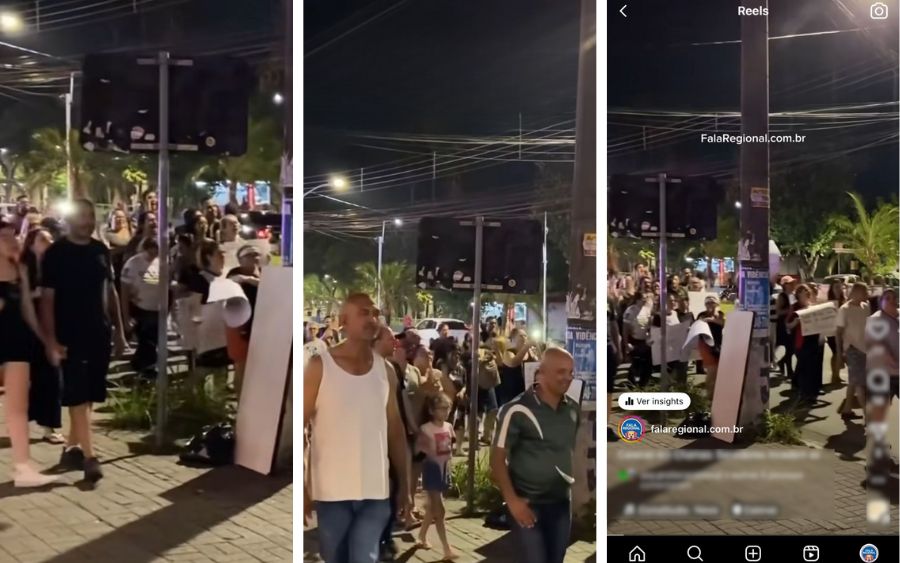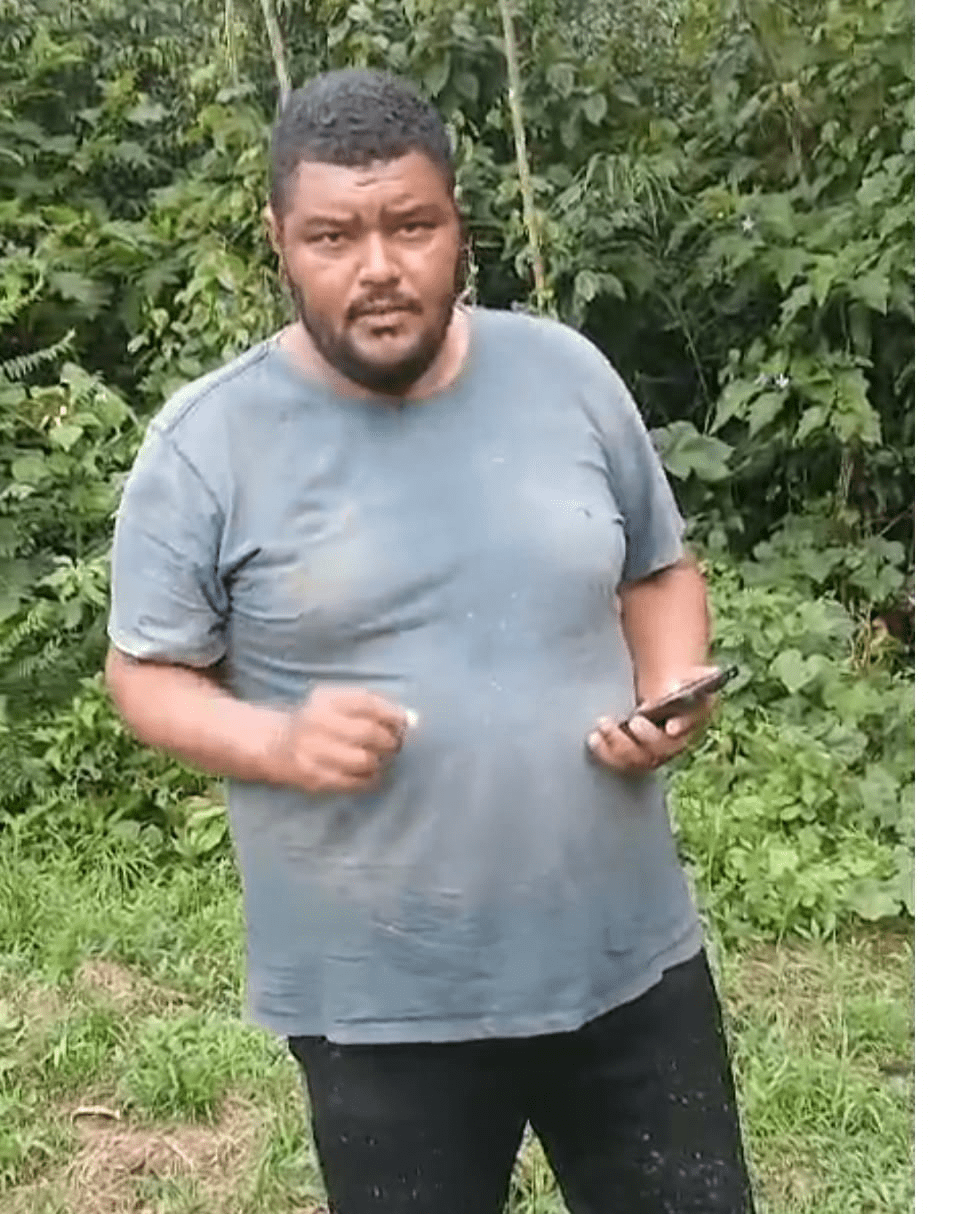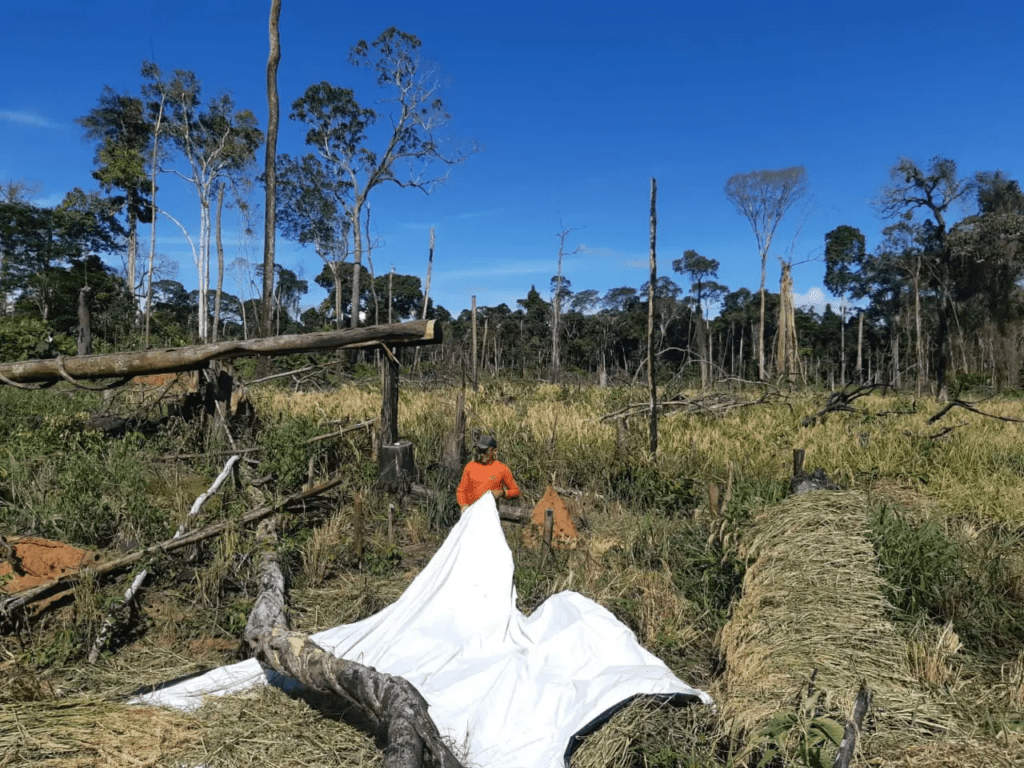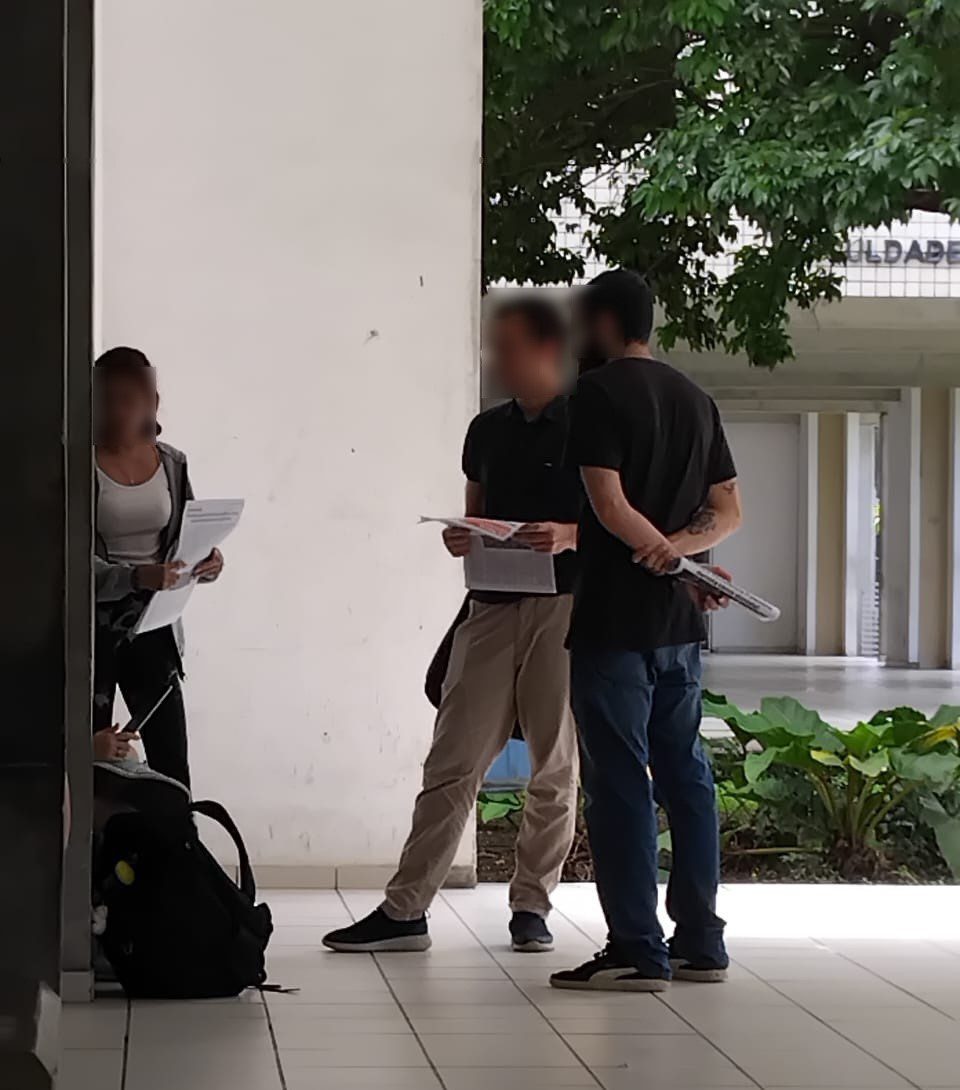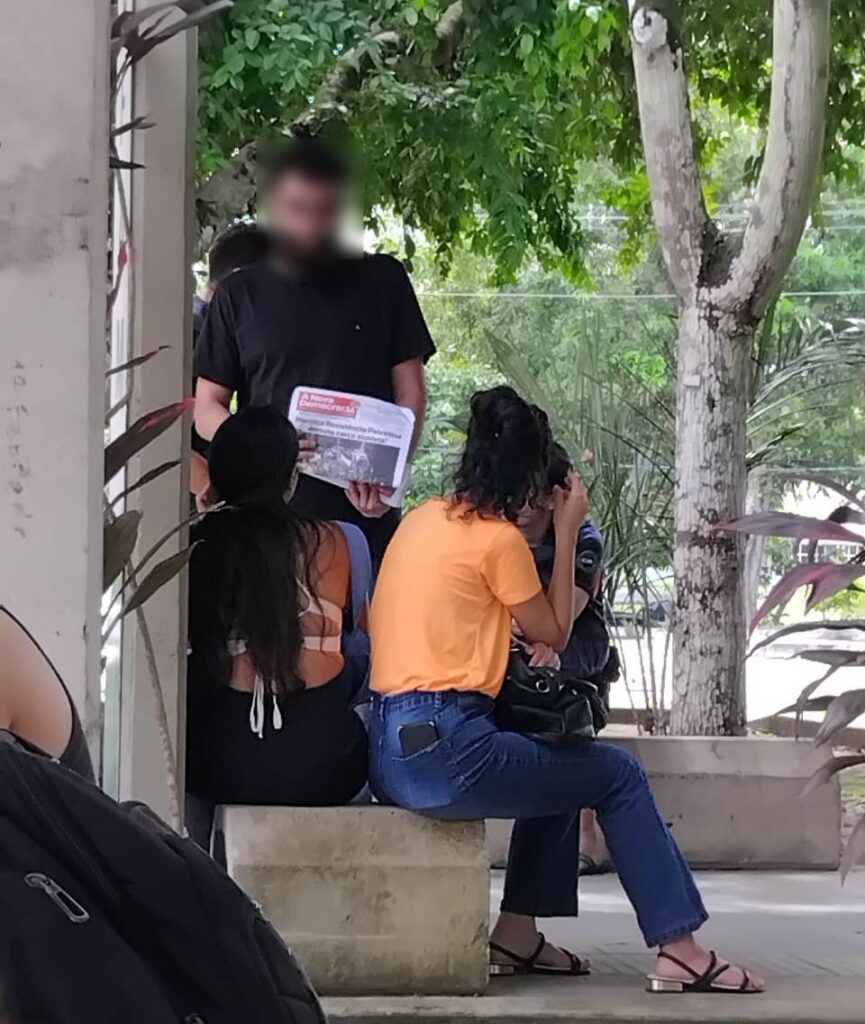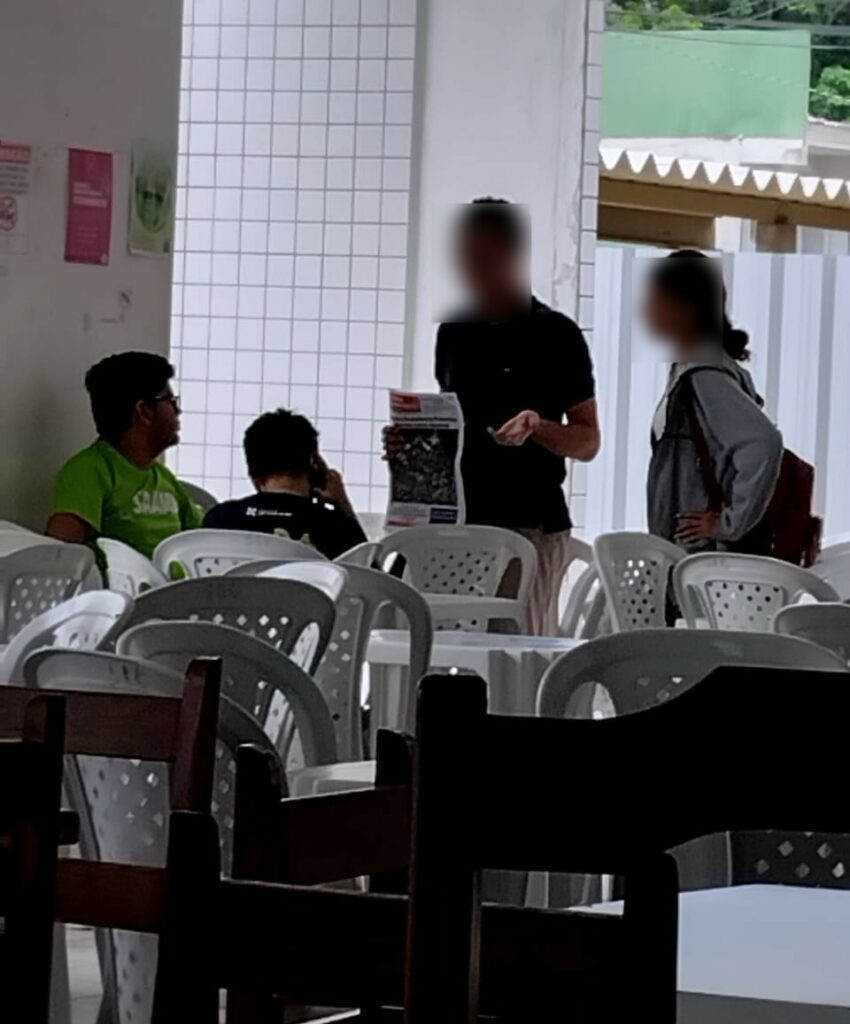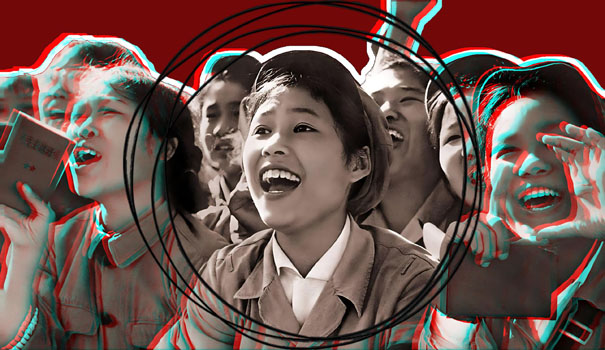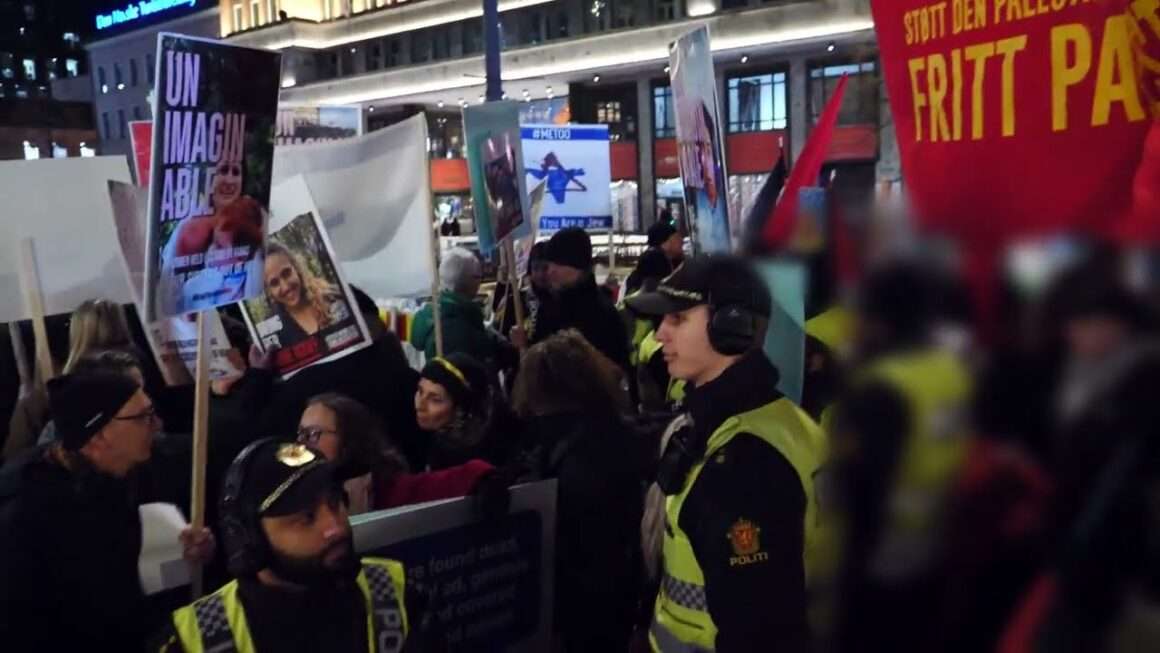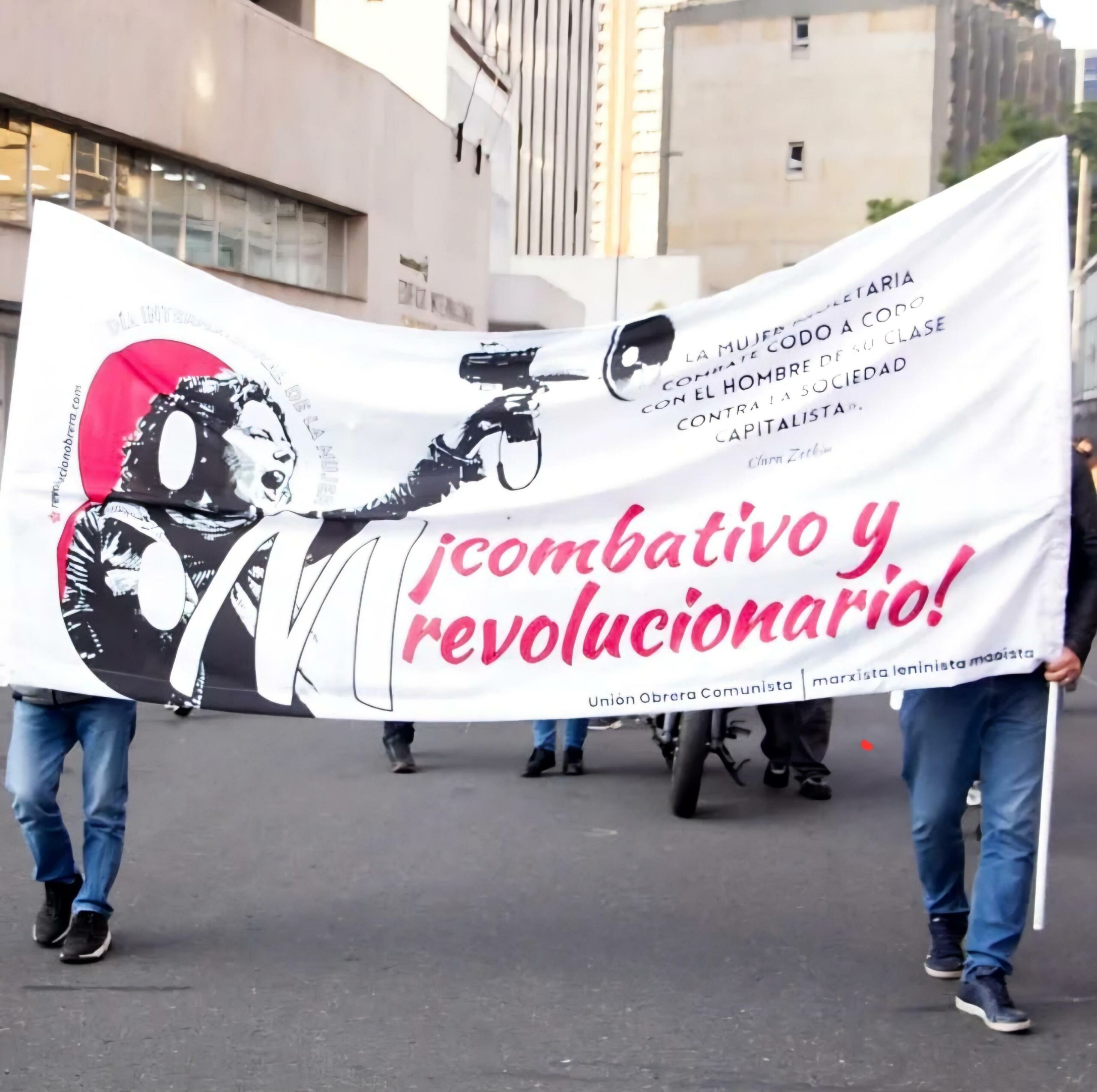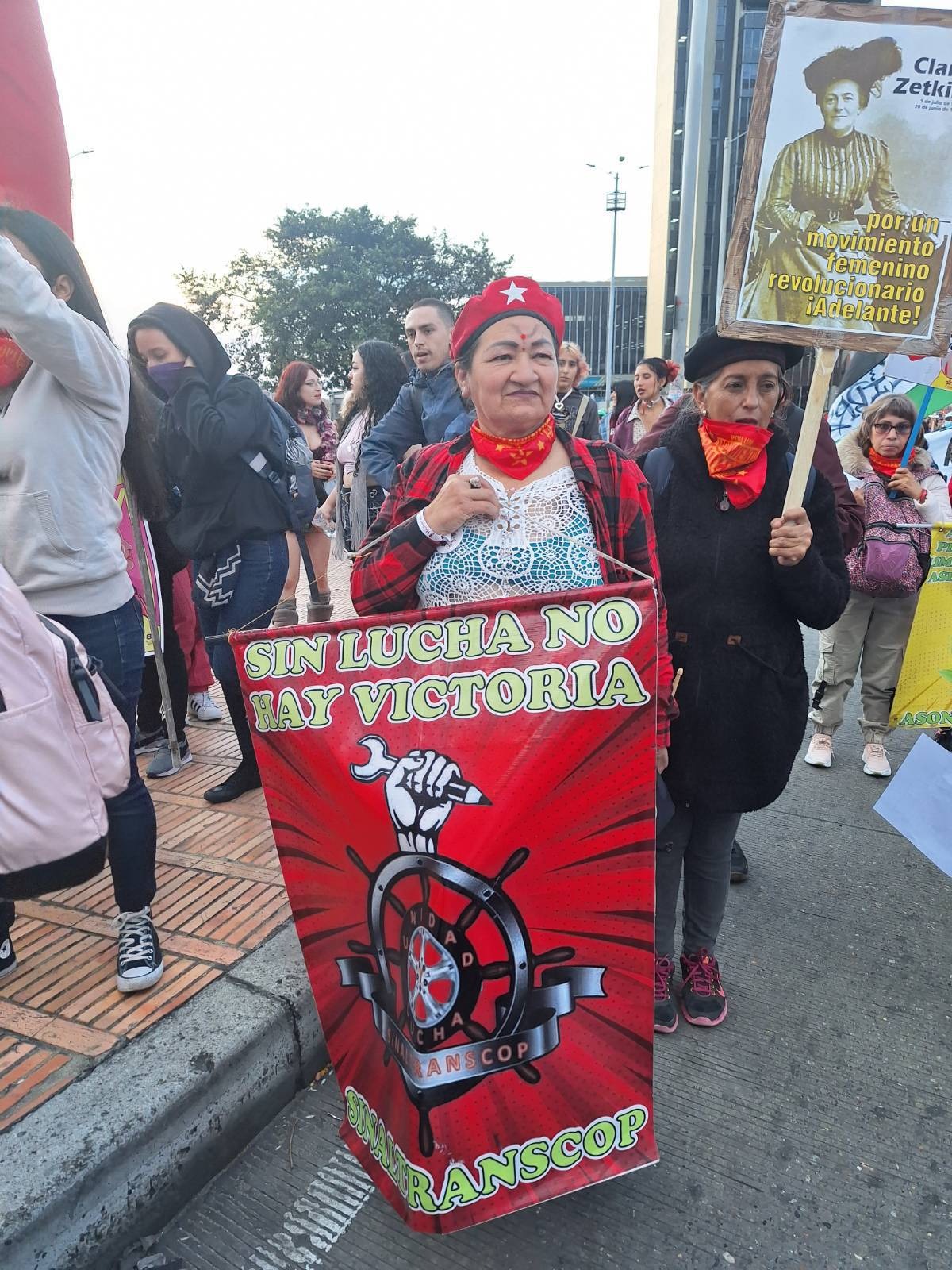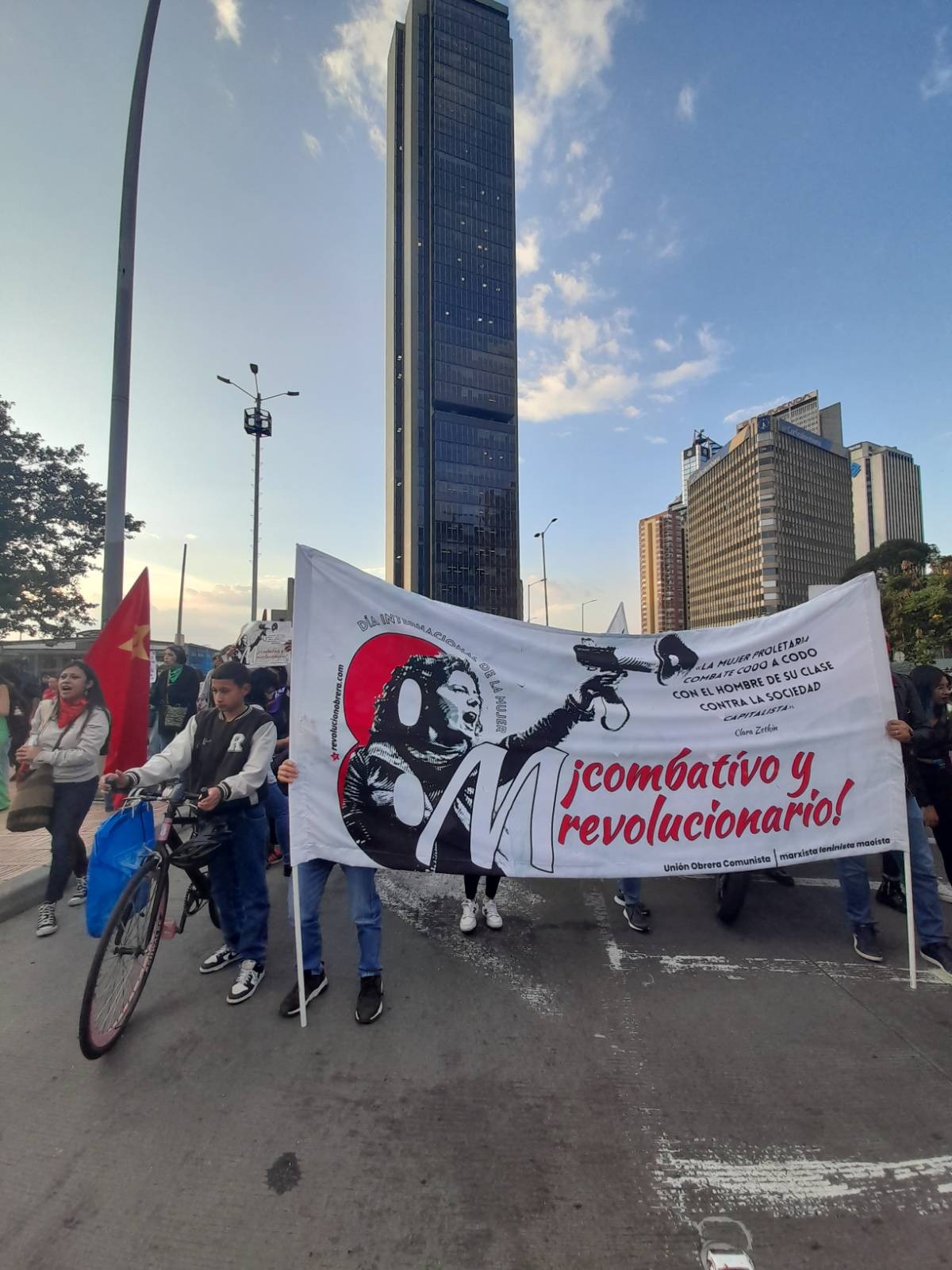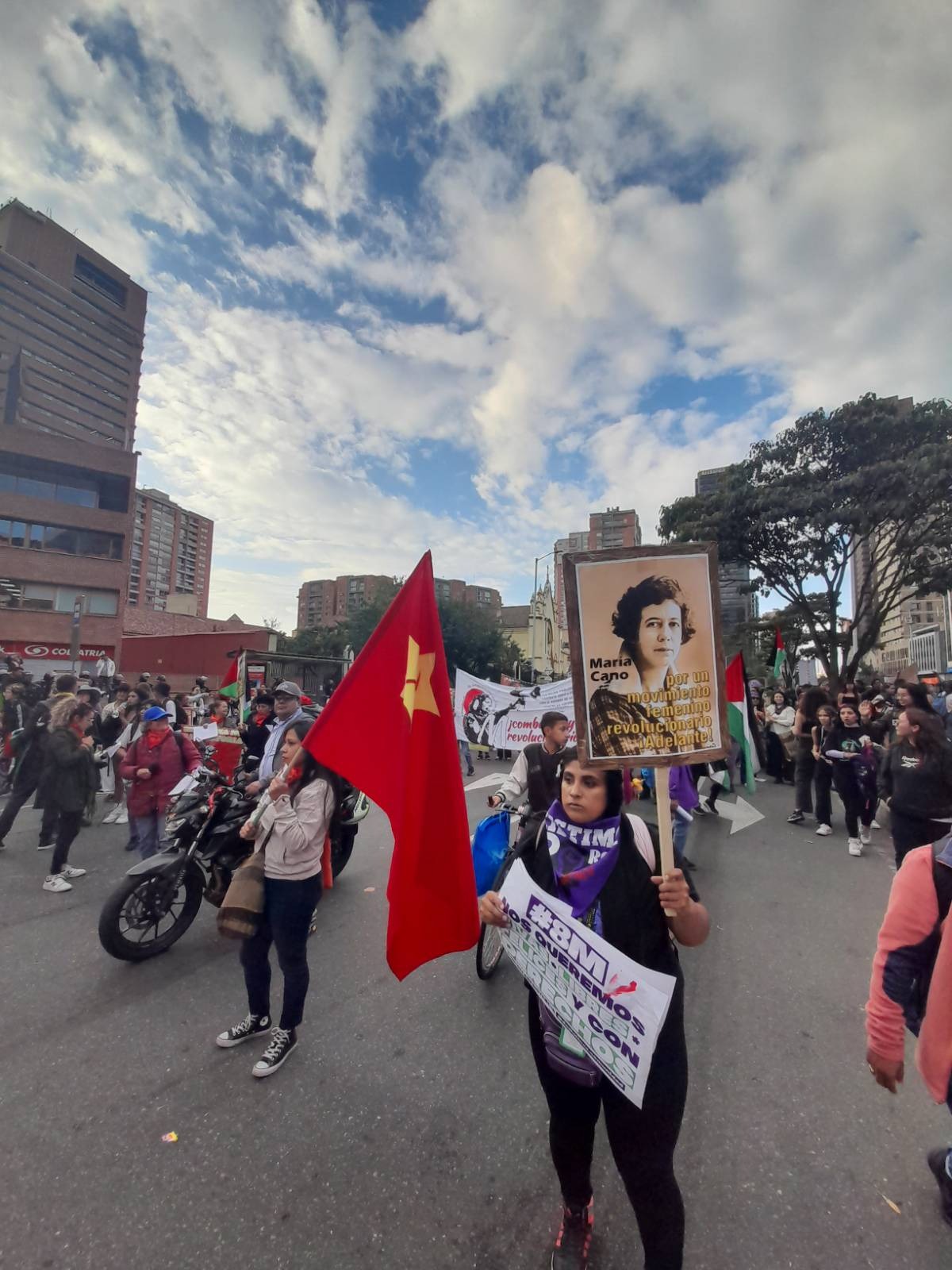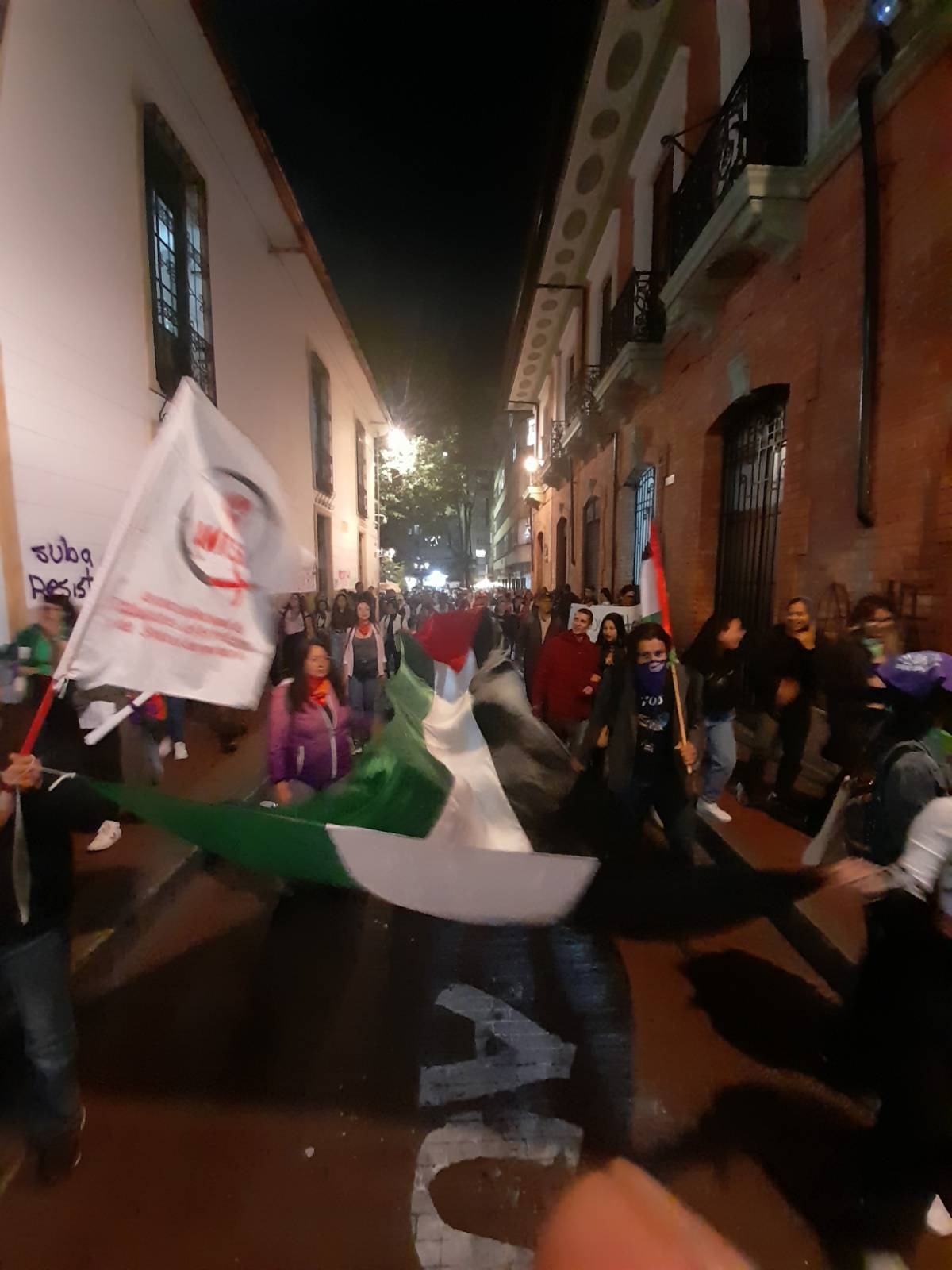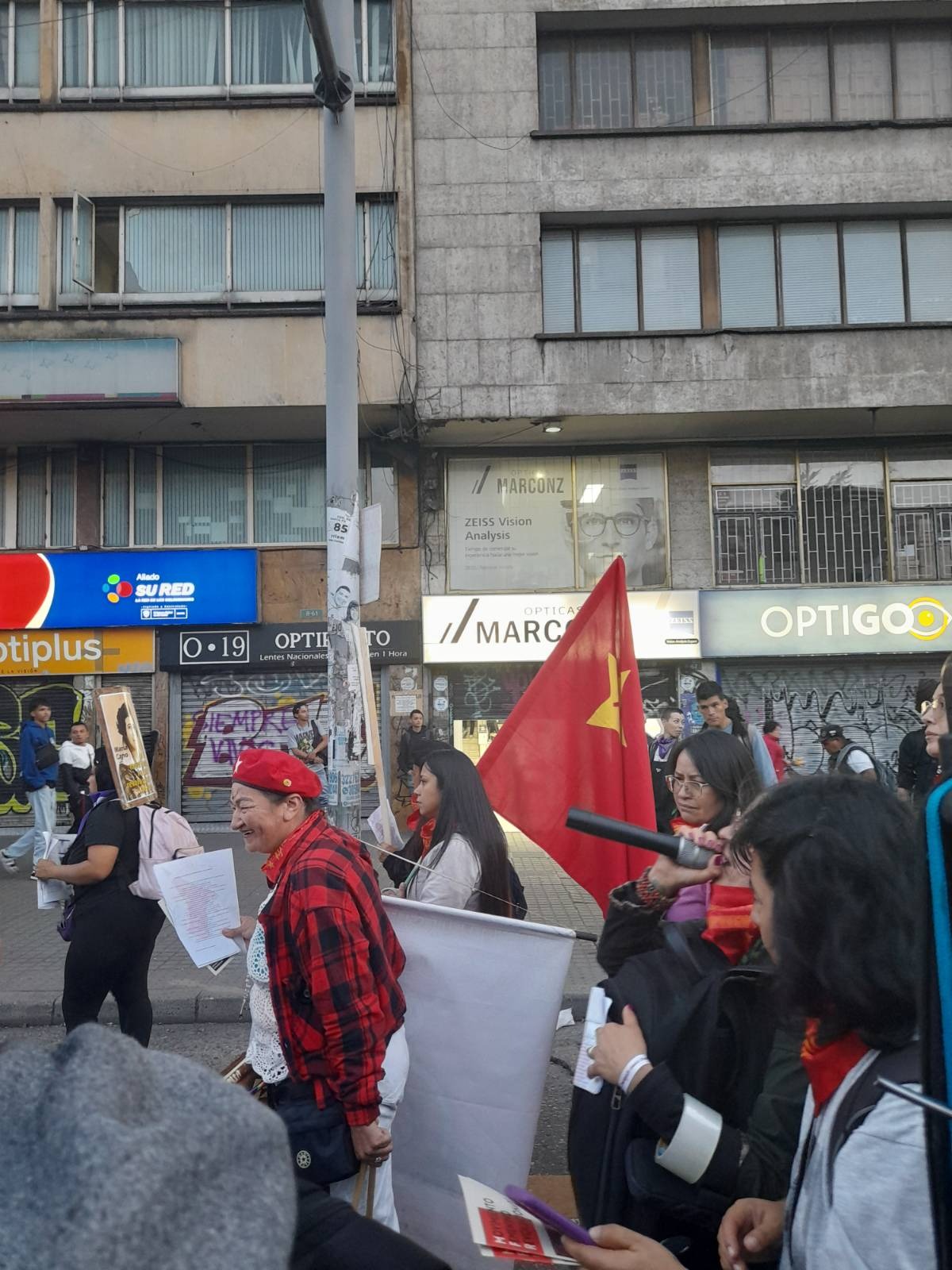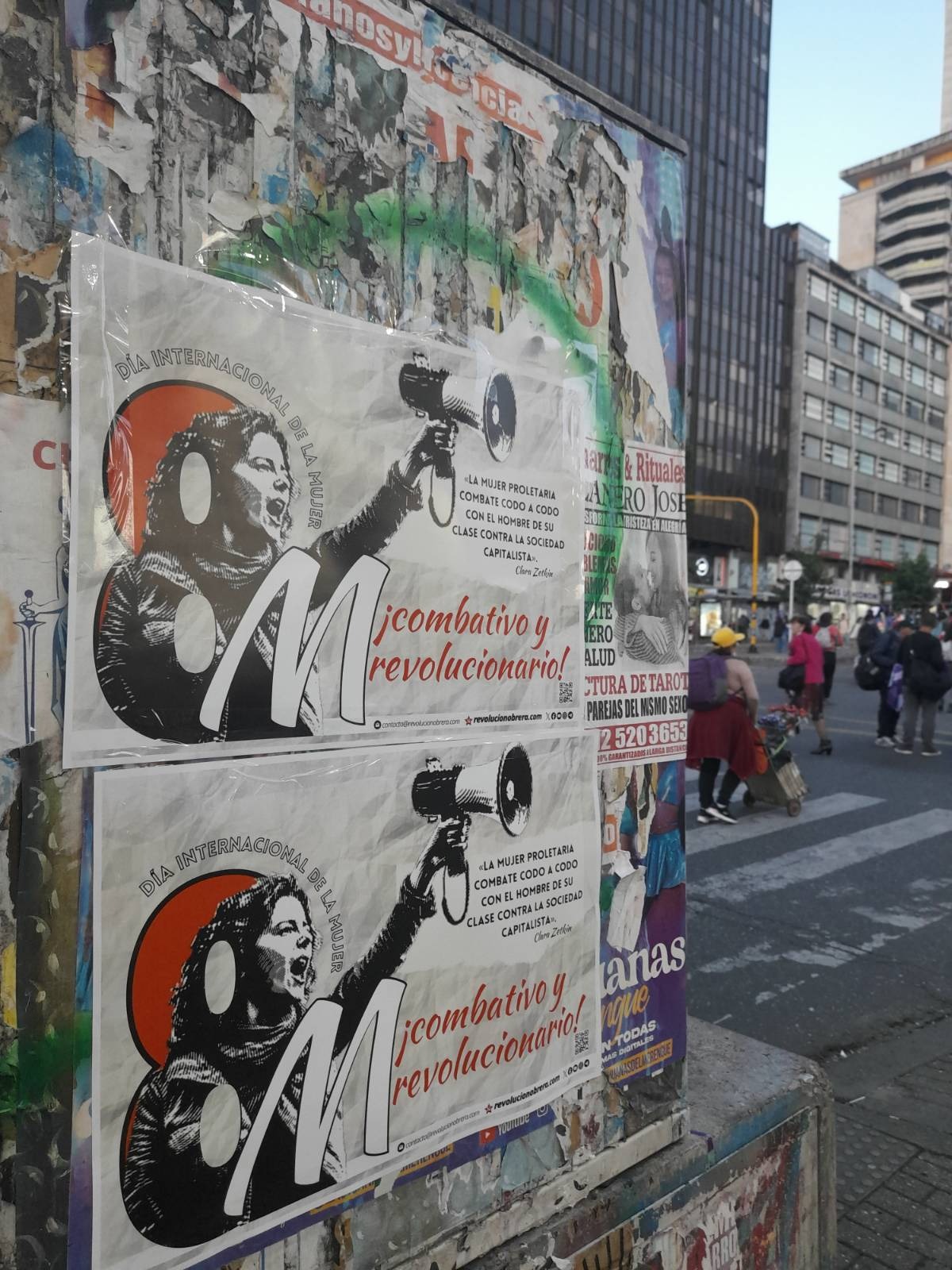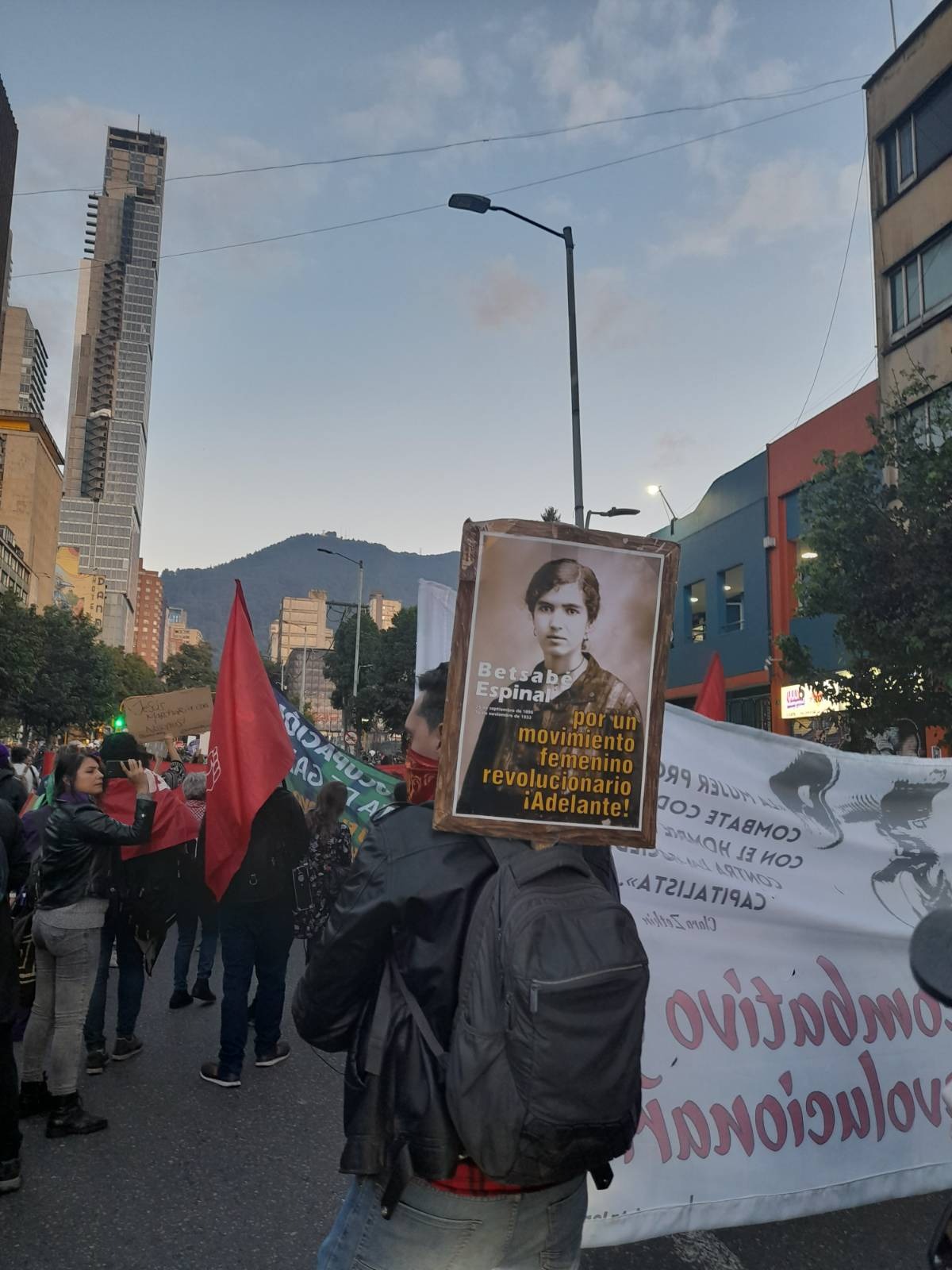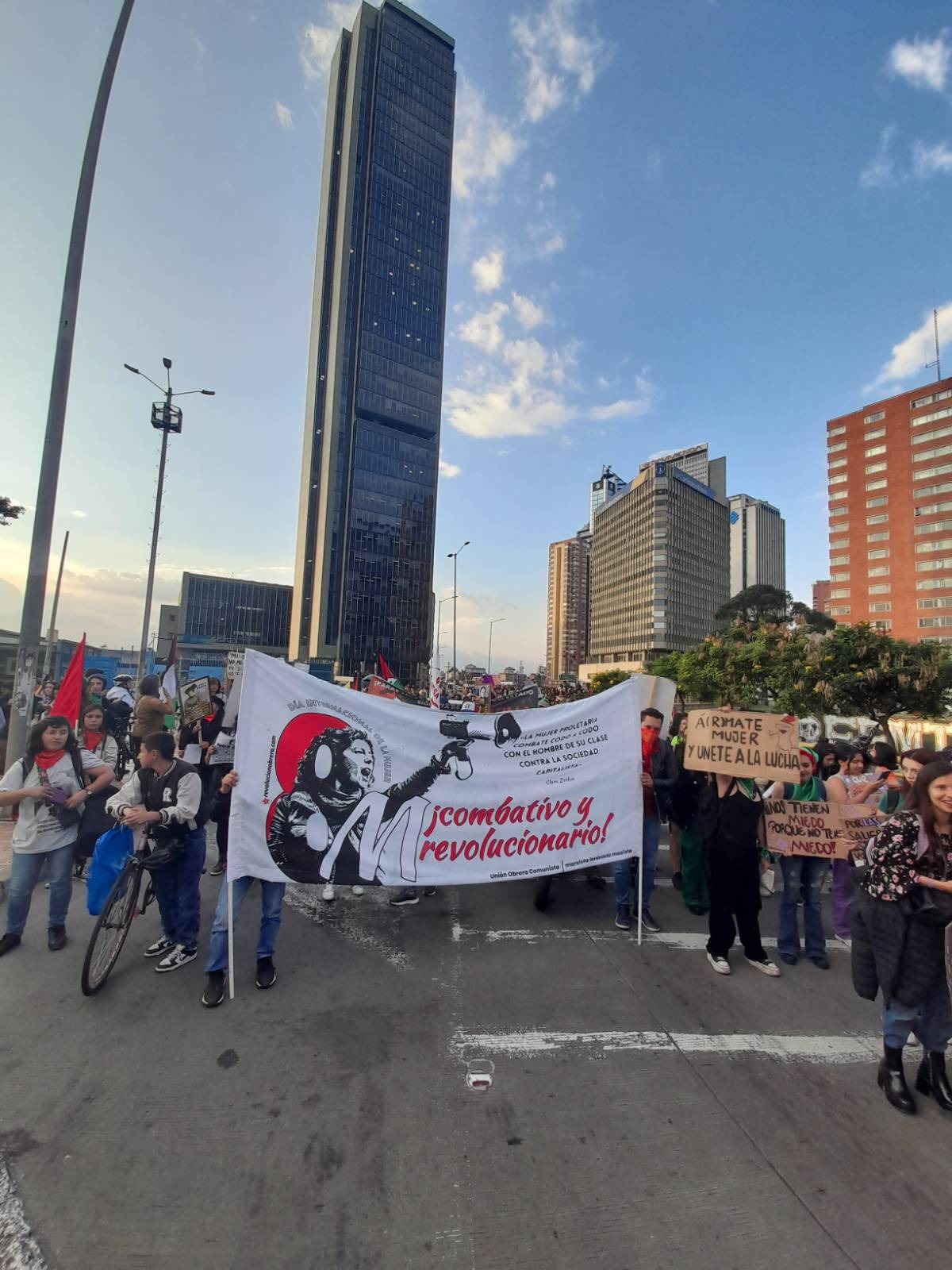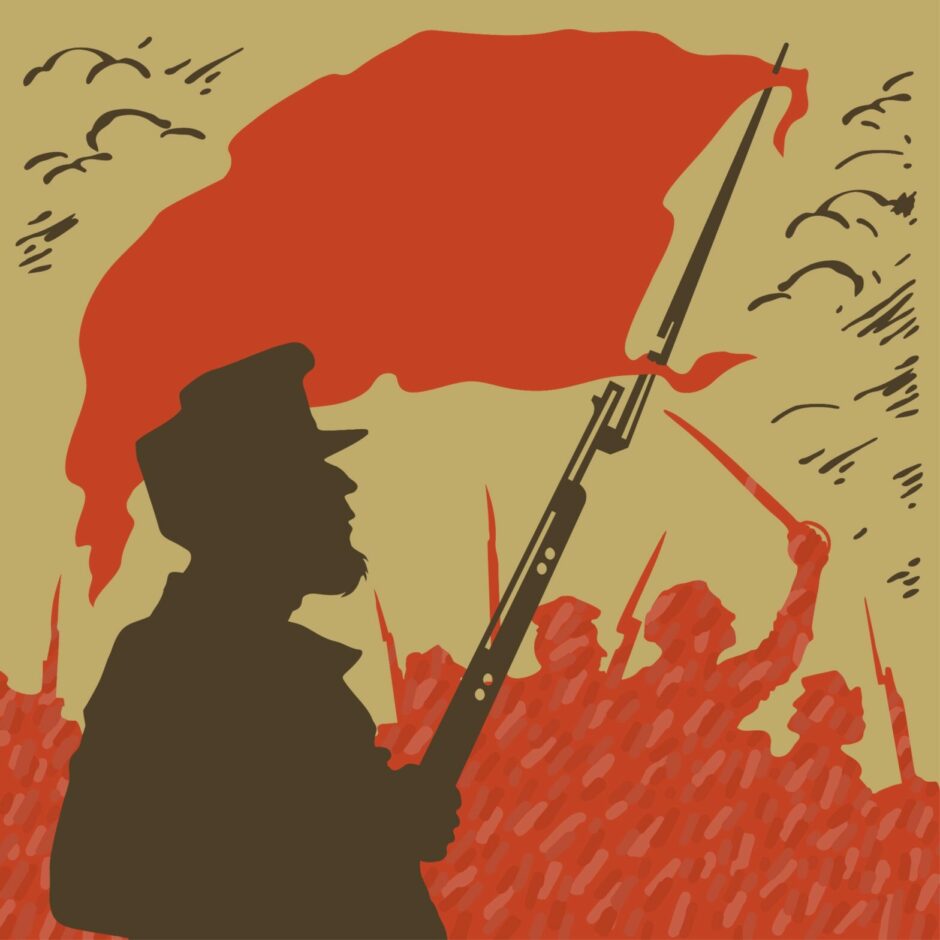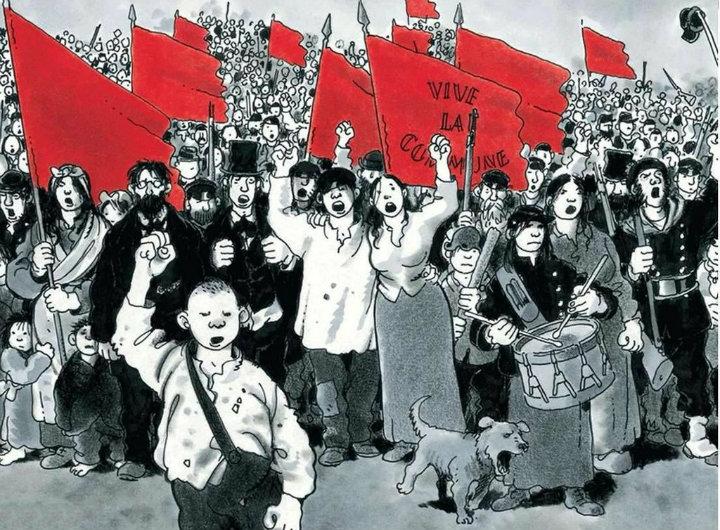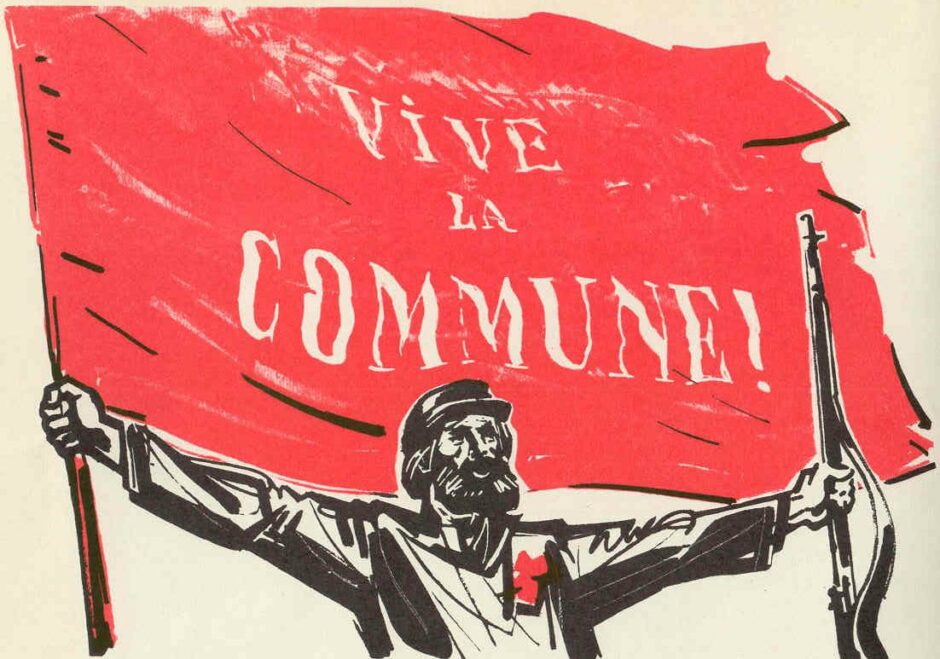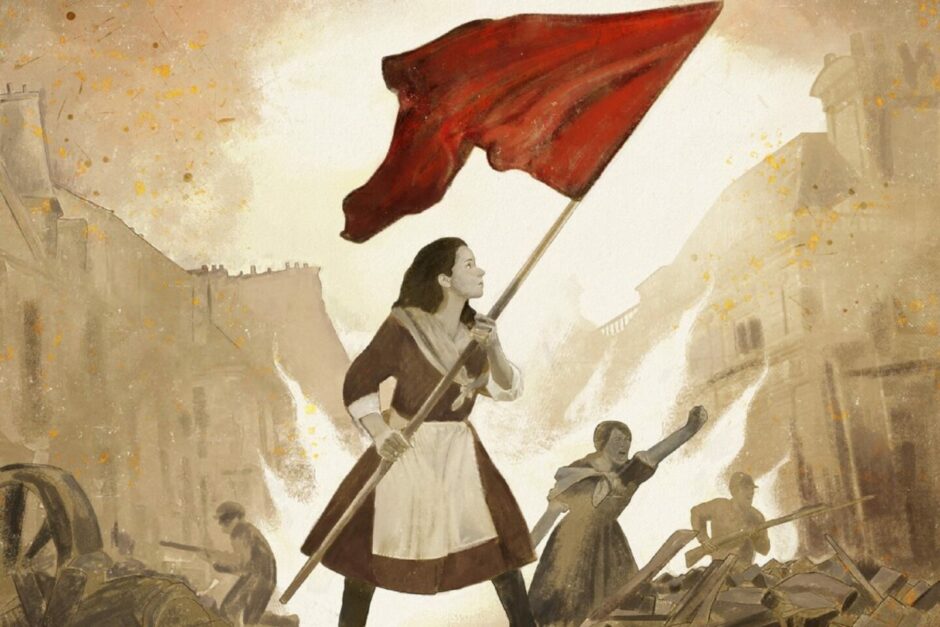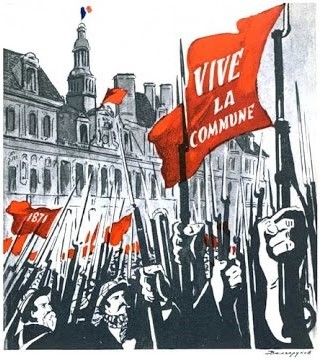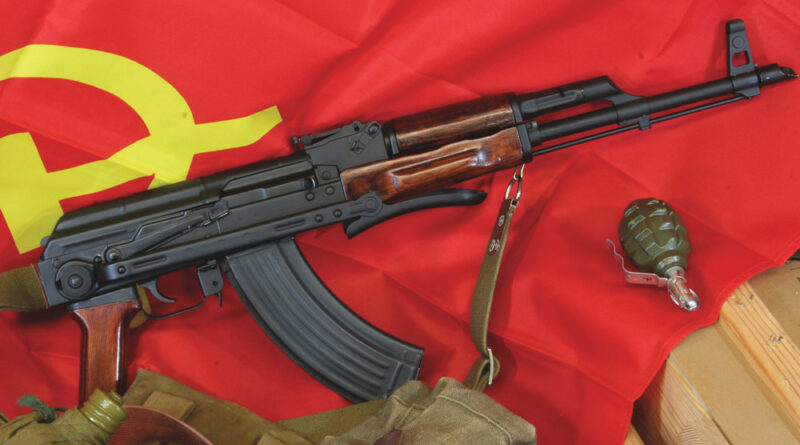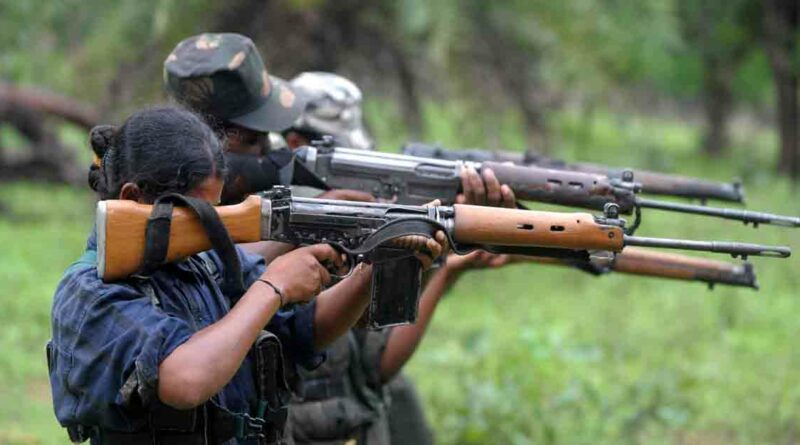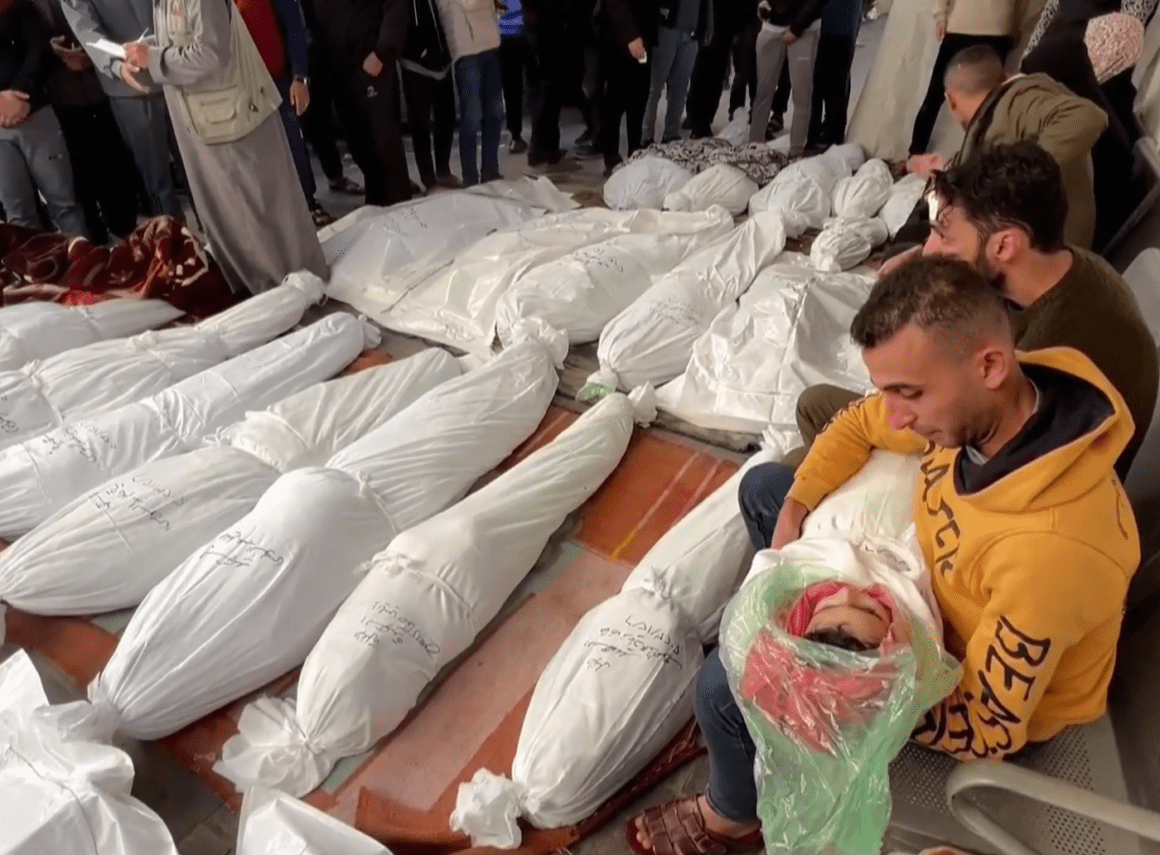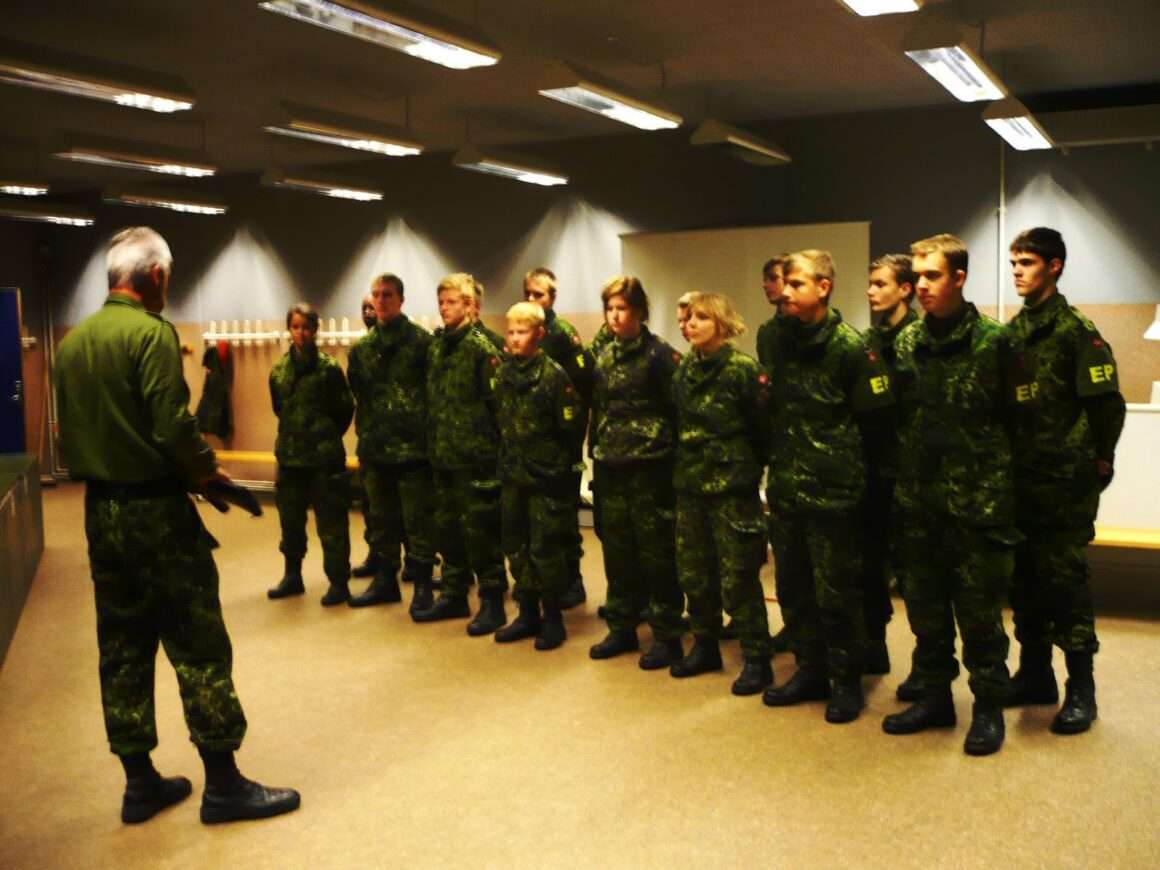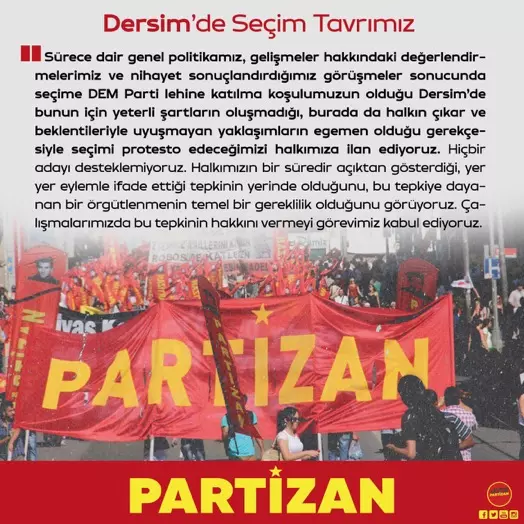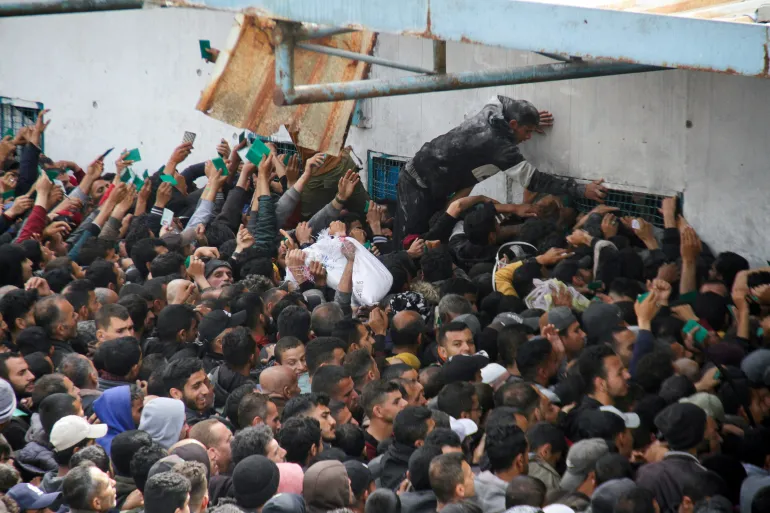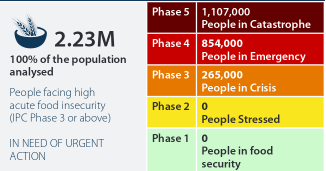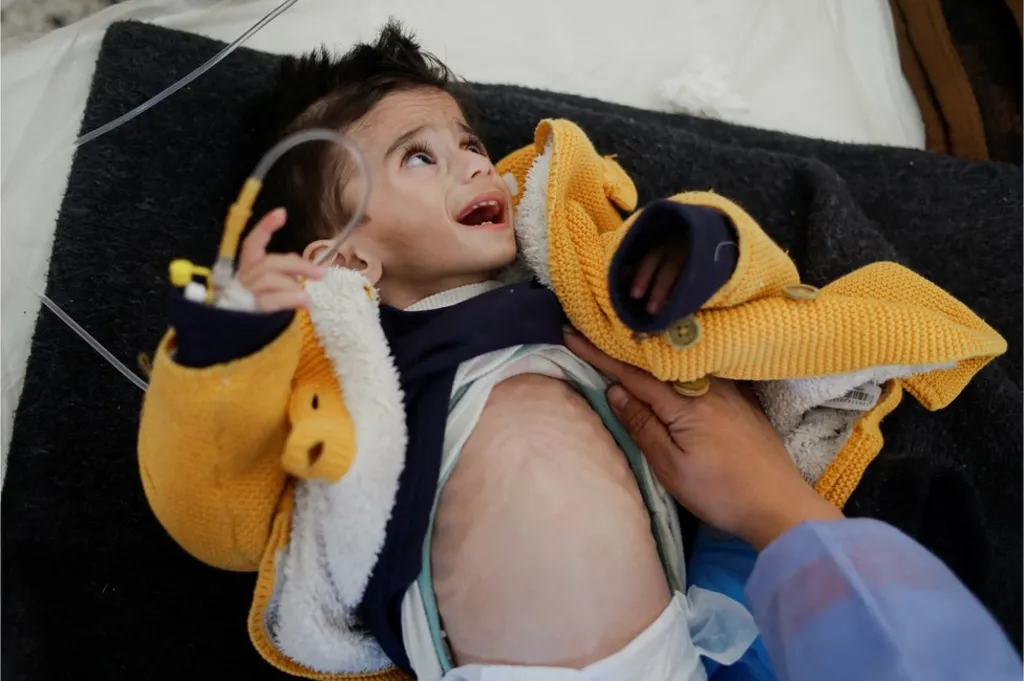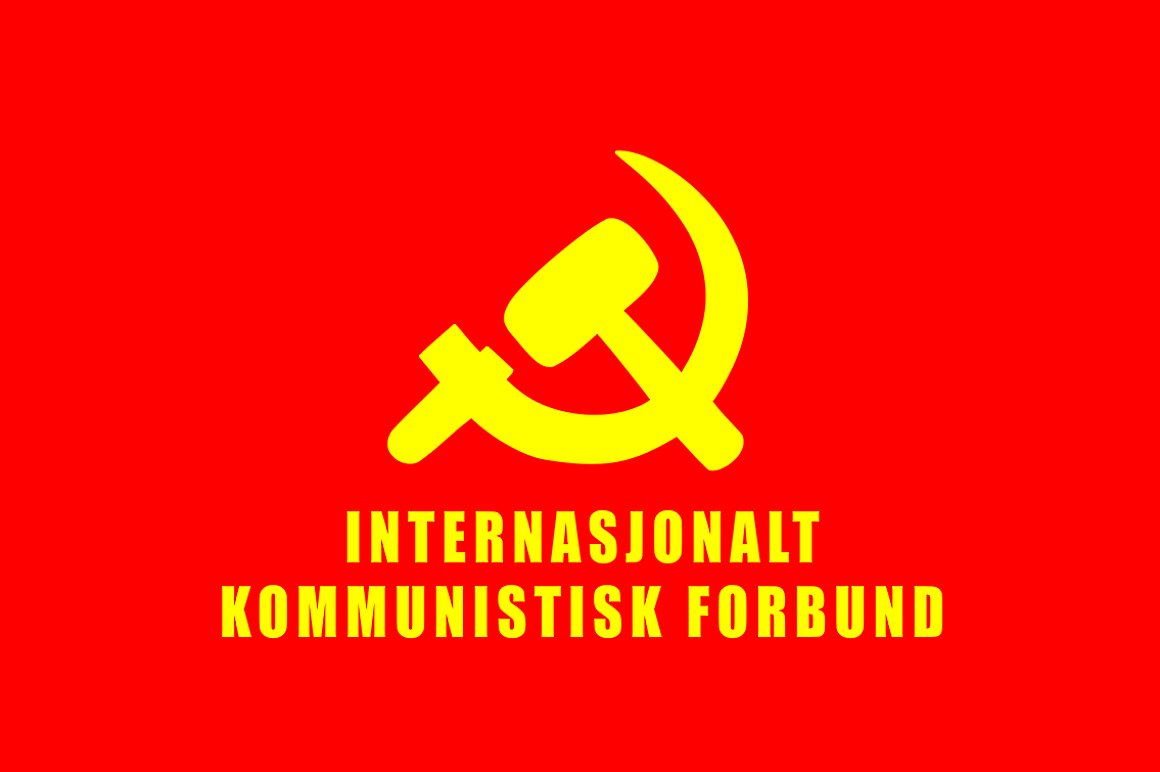PDF Content:
PDF Source:
THE GAZA STRIP FAMINE IS IMMINENT AS 1.1 MILLION PEOPLE, HALF OF GAZA, EXPERIENCE CATASTROPHIC FOOD INSECURITY Overview The IPC acute food insecurity analysis conducted in December 2023 warned of a risk that Famine may occur by the end of May 2024 if an immediate cessation of hostilities and sustained access for the provision of essential supplies and services to the population did not take place. Since then, the conditions necessary to prevent famine have not been met and the latest evidence confirms that Famine is imminent in the northern governorates and projected to occur anytime between mid-March and May 2024. CURRENT: 15 FEBRUARY - 15 MARCH 2024 2.13M 95% of the population analysed People facing high acute food insecurity (IPC Phase 3 or above) IN NEED OF URGENT ACTIONPhase 5 677,000 People in Catastrophe Phase 4 876,000 People in Emergency Phase 3 578,000 People in Crisis Phase 2 96,000 People Stressed Phase 1 0 People in food security PROJECTED: 16 MARCH - 15 JULY 2024 2.23M 100% of the population analysed People facing high acute food insecurity (IPC Phase 3 or above) IN NEED OF URGENT ACTIONPhase 5 1,107,000 People in Catastrophe Phase 4 854,000 People in Emergency Phase 3 265,000 People in Crisis Phase 2 0 People Stressed Phase 1 0 People in food security IPC ACUTE FOOD INSECURITY ANALYSIS 15 FEBRUARY - 15 JULY 2024 Published on 18 March 2024IPC Global Initiative - Special Brief IPC Special Briefs are produced by the IPC global initiative and do not necessarily reflect the views of stakeholders in Palestine. This analysis factors in all data and information available up to 10 March 2024 and does not take into account the latest developments on the ground. Key Drivers Restricted humanitarian access Extremely limited humanitarian access to and within the Gaza Strip continues to impede the safe and equitable delivery of life-saving multi-sector humanitarian assistance critical for Famine prevention and response. This includes severe limitations to the supply of goods as well as basic services.Hostilities Hostilities continue to involve the besiegement of the entire population and widespread, intense and sustained ground and air operations and clashes. This has caused over 31,000 deaths and injured 73,000 people, displaced about 1.9 million people, damaged or destroyed over half of the buildings, and devastated assets and infrastructure indispensable to survival, including across the food, health and water systems.Current Acute Food Insecurity | 15 February - 15 March Projected Acute Food Insecurity | 16 March - 15 July
According to the most likely scenario, both North Gaza and Gaza Governorates are classified in IPC Phase 5 (Famine) with reasonable evidence, with 70% (around 210,000 people) of the population in IPC Phase 5 (Catastrophe). Continued conflict and the near-complete lack of access to the northern governorates for humanitarian organizations and commercial trucks will likely compound heightened vulnerabilities and extremely limited food availability, access, and utilization, as well as access to healthcare, water, and sanitation. The famine threshold for household acute food insecurity has already been far exceeded and, given the latest data showing a steeply increasing trend in cases of acute malnutrition, it is highly likely that the famine threshold for acute malnutrition has also been exceeded. In North Gaza, acute malnutrition (by Mid-Upper Arm Circumference - MUAC) moved from a pre-escalation estimated of 1 percent to 6.8 – 9.1 percent in January and 12.4 to 16.5 percent in February (weighted for children 6-59). Acute malnutrition (by MUAC) among children 6-23 months old increased in the same period from 16.2 percent to 29.2 percent. The upward trend in non-trauma mortality is also expected to accelerate, resulting in all famine thresholds likely to be passed imminently. The southern governorates of Deir al-Balah and Khan Younis, and the Governorate of Rafah, are classified in IPC Phase 4 (Emergency). However, in a worst-case scenario, these governorates face a risk of Famine through July 2024. The entire population in the Gaza Strip (2.23 million) is facing high levels of acute food insecurity. From mid-March to mid-July, in the most likely scenario and under the assumption of an escalation of the conflict including a ground offensive in Rafah, half of the population of the Gaza Strip (1.11 million people) is expected to face catastrophic conditions (IPC Phase 5), the most severe level in the IPC Acute Food Insecurity scale. This represents an increase of 530,000 people (92 percent) compared to the previous analysis. Between the current and the projection period, around 400,000 more people are expected to slide into IPC Phase 5 (Catastrophe). The rest of the population faces Emergency (IPC Phase 4) (854,000 people, 38 percent of the population) or Crisis (IPC Phase 3) (265,000 people, 12 percent of the population). The escalation of the hostilities has caused widespread damage to assets and infrastructure indispensable to survival. About 50 percent of buildings - and more than 70 percent in the northern governorates - have been damaged or destroyed. This has included dwellings, shops and infrastructure, such as hospitals, schools, as well as water, sanitation and other facilities. Assets and infrastructure necessary for food production and distribution have also been destroyed or severely damaged, extremely limiting the functionality of the food system. From a pre-escalation average of 500 trucks a day of which 150 carrying food, in the period between 7 October 2023 to 24 February 2024, only 90 trucks per day, of which only 60 carrying food, entered the Gaza Strip. Consequently, virtually all households are skipping meals every day and adults are reducing their meals so that children can eat. In the northern governorates, in nearly two thirds of the households, people went entire days and nights without eating at least 10 times in the last 30 days. In the southern governorates, this applies to one third of the households.
THE GAZA STRIP | IPC SPECIAL BRIEF3 CURRENT SITUATION MAP AND POPULATION TABLE (15 February - 15 March 2024 ) Population table for the current situation: 15 February - 15 March 2024 Note: A population in Phase 3+ does not necessarily reflect the full population in need of urgent action. This is because some households may be in Phase 2 or even 1 but only because of receipt of assistance, and thus, they may be in need of continued action. Marginal inconsistencies that may arise in the overall percentages of totals and grand totals are attributable to rounding.GovernorateTotal population analysedPhase 1 Phase 2 Phase 3 Phase 4 Phase 5 Phase 3+Area Phase#people % #people % #people % #people % #people % #people % Deir al-Balah & Khan Younis governorates600,000 0 030,000 5120,000 20 270,000 45 180,000 30 570,000 95 4 North Gaza & Gaza governorates300,000 0 0 0 0 60,000 20 75,000 25 165,000 55 300,000 100 4 Rafah governorate1,326,544 0 066,327 5397,963 30 530,618 40 331,636 25 1,260,217 95 4 Grand Total 2,226,544 0 096,327 5 577,963 26 875,618 39 676,636 30 2,130,217 95
THE GAZA STRIP | IPC SPECIAL BRIEF4 CURRENT SITUATION OVERVIEW (15 February - 15 March 2024) Vulnerabilities and Acute Events Prior to the current hostilities, vulnerability was high in the Gaza Strip due to prolonged blockade and periodic escalations in hostilities that severely damaged the food system in the area. At 5,900 residents per square kilometre, one of the most densely populated areas in the world even before the concentration of most of the population in only one of five governorates, the Gaza Strip population is extremely reliant on the cross-border movement of goods and utilities like electricity and water. In 2022, the Gaza Strip faced an unemployment rate of nearly 45 percent 1 and, by September 2023, the poverty rate was at 60 percent 2, among a population that included nearly 70 percent of refugees. 3 Due to severely constrained livelihood opportunities, in 2022, over half of the population was relying on humanitarian assistance as their main income source and about one-third on casual labour, 4 with 70 percent of the population food insecure. 5 Conflict . As of 14 March 2024, the ongoing hostilities have reportedly caused nearly 105,000 casualties within the Gaza Strip – nearly 5% of the total population. 6 This includes over 73,000 people injured, about half of them women and children, and over 31,000 deaths. The escalation of hostilities within the Gaza Strip began with heavy bombardment on 7 October 2023. 7 On 27 October, major ground operations and clashes reportedly began within the Gaza Strip. 8 These started in the northern governorates and continued through 23 November, with a humanitarian pause from 24 November through 30 November. 9 Hostilities subsequently resumed at high intensity, with major ground operations and bombardment by air, land, and sea. This included the continued expansion of a ground operation in Khan Younis Governorate, centred on Khan Younis city. 10 Another large ground operation began in Deir al-Balah Governorate on 24 December 2023, 11 expanding across multiple though not all refugee camps and urban areas in the governorate. These operations were accompanied by continued clashes among armed actors. Clashes in the northern governorates, especially some neighbourhoods of Gaza city like Zeitoun, re-escalated in late February 2024. 12 Bombardment by air, land, and sea of all areas of the Gaza Strip has continued throughout this period, intensifying particularly before and during major ground operations. Humanitarian access. Conflict continues to place severe limitations on the ability of humanitarian organizations to deliver life-saving food, nutrition, health, water, hygiene, sanitation and other life-saving assistance to the besieged population. Commercial traffic is similarly impeded. Humanitarian access, and the ability of the most vulnerable populations to access and participate in humanitarian activities safely is highly limited and uneven across the Gaza Strip. Once humanitarian assistance and commercial goods enter the Gaza Strip, onward access to the northern governorates is extremely limited and unavailable for extended periods, while access is relatively higher for the southern governorates, particularly Rafah Governorate. While there has been improvement in access to the Gaza Strip relative to early October 2023, including the opening of the Kerem Shalom crossing in Mid-December 2023, access to the Gaza Strip continues to fluctuate and remains insufficient for meeting the basic needs of the overall population. Severe limitations and attacks on humanitarian staff and assets forced major providers of humanitarian food and other assistance to the northern governorates to suspend convoys to these areas, including the World Food Programme, on 20 February. 13 Since the previous IPC analysis on the Gaza Strip in December 2023, access denial increased significantly, especially in the northern governorates. In January 2024, only nine humanitarian missions to the northern governorates were facilitated, dropping to six missions in February. 14 Figure 1. Casualties in the Gaza Strip reported by the Palestinian Ministry of Health as of 14 March 2024. Source: Health Cluster
THE GAZA STRIP | IPC SPECIAL BRIEF5 According to OCHA, constraints on humanitarian action throughout the Gaza Strip include direct strikes with explosive weapons on humanitarian convoys, detention of humanitarian staff, road closures, checkpoints, and related blockages or delays on main transportation corridors. Swarming of humanitarian convoys subsequently increased, including at several hotspots throughout the Gaza Strip, such as immediately after crossing Wadi Gaza into the northern governorates. Physical access constraints further limit the movement of humanitarian and commercial traffic, including road damage from bombardment and traffic of heavy military vehicles as well as the accumulation of an estimated 12,000 metric tons of debris that may take up to four years to fully clear. 15 Displacement and Movement Restrictions. Displacement continues to be driven by conflict. An evacuation order was issued to the entire population residing north of Wadi Gaza (1.1 million people) on 13 October, 16 followed by orders and accompanying maps indicating to move as far south as Khan Younis Governorate. 17 After the humanitarian pause on 24- 30 November 2023, new evacuation orders covering at least 30 percent of the entire Gaza Strip were issued. 18 The unilaterally declared Al-Mawasi “Humanitarian Zone” was first announced on 18 October 2023, however, humanitarian agencies did not agree to the establishment of such zones. 19 The proposed area has limited pre-existing services, with OCHA reporting there is “almost no sheltering capacity” . 20 In addition to the closure of some of the main transportation corridors within the Gaza Strip, other movement restrictions have also been announced, including a ban on movement from southern to northern governorates. 21 Additional restrictions imposed on populations affect livelihoods and food access, such as a de facto prohibition on fishing and movement within one kilometre of the border fence, which covers a significant proportion of farmland. 22 The movement of livestock together with displaced populations has not generally been reported and livestock abandonment is likely high.Map 1. Missions planned, facilitated and denied, October 2023 to Mid-February 2024. Source: OCHA Map 2. Distribution of IDPs staying in Collective Centres. Source: Shelter Cluster
THE GAZA STRIP | IPC SPECIAL BRIEF6 As new evacuation orders are issued alongside with continuation of bombardments and ground operations, Internally Displaced Persons (IDPs) are constantly moving in search of safety. Most of them have moved south, largely to Rafah Governorate. 23 The population in Rafah has increased about five-fold as a result, rapidly rising from 276,000 pre-escalation to over 1.3 million as of February 2024. A large proportion of the displaced population is from Gaza and North Gaza Governorates, which have seen their population decrease by 84 percent and 75 percent respectively. 24 Rafah Governorate, which spans over 65 km 2, now hosts around 1.3 million people. 25 In Rafah, there are 35 UNRWA shelters hosting 882,800 people and another 30 informal shelters hosting 506,300 people, 26 corresponding to over 30 percent of the population staying in shelters. The formal shelters managed by UNRWA are overcrowded with severely limited access to safe Water, Sanitation and Hygiene (WASH) and other services. People in informal shelters face even more difficulties accessing health, food and non-food services. The lack of Non-food Items (NFIs) provision in informal settlements has led people to set up makeshift shelters and tents, which are subject to flooding on rainy days, further exacerbating the suffering of displaced people. 27 Damages . Destruction and damage of buildings, particularly from bombardment by air, land, and sea, is evident in all governorates of the Gaza Strip. According to the recent satellite assessments, by late February 2024, at least 54 percent of all buildings in the Gaza Strip were likely damaged or destroyed. The largest scale destruction is in Gaza Governorate where more than 73 percent of buildings are estimated to be destroyed, followed by North Gaza (70 percent), Deir al-Balah (44 percent), Khan Younis (52 percent) and Rafah (28 percent). 28 This has included dwellings, shops and various types of infrastructure, such as hospitals, schools, and other public buildings, as well as WASH infrastructure and storage facilities, among others. Food Availability Production . The escalation of hostilities and mass displacements have caused food shortages and unavailability throughout the Gaza Strip as the food system and agriculture value chains have collapsed or are marginally surviving through the informal market. A significant portion of agriculture land, encompassing orchards, greenhouses, and farmlands has suffered extensive destruction. According to the UNOSAT, the percent of damaged agriculture land has increased from 25 percent to 60 percent, between November 2023 and January 2024.29 Extensive damage has been inflicted on the local food system, including agricultural infrastructure. More than 300 home barns, 100 agricultural warehouses, 46 farm storages, 119 animal shelters, 200 farms, as well over 600 wells used for irrigation have been destroyed, amongst other agriculture facilities.30 According to the FAO damage assessment of February 2024, damage to wells was found to be most concentrated in the North Gaza and Gaza Governorates; and in some areas, all the wells were damaged. Additionally, over 26 percent (336) of all greenhouses have been damaged across all governorates. The governorates with the highest Map 3. Gaza Damage Mapping 26.02.2024. Source: Decentralized Damage Mapping Group Map 4. Damage to Agriculture Areas Imagery Analysis Maps - November 2023 (left), December 2023 (middle) and January 2024 (right). Source: UNOSAT, 2023-2024
THE GAZA STRIP | IPC SPECIAL BRIEF7 damage are Gaza (55 percent), North Gaza (48 percent), Khan Younis (35 percent), Deir al-Balah (20 percent) and Rafah (16 percent). The Governorate of Khan Younis had the largest area of damaged greenhouses (149 hectares), followed by Rafah (89 hectares). More than 40 percent (6,694 ha) of all croplands has been damaged since 7 October, with the highest reported damages in Gaza (55 percent, 1,941 ha), Deir al-Balah (51 percent, 1,408 ha), North Gaza (45 percent, 1,402 ha), Khan Younis (33 percent, 1,492 ha) and Rafah (25 percent, 451 ha) Governorates. In terms of cropland type, 41 percent of irrigated land, 43 percent of orchards and 42 percent of rainfed land have been damaged.31 The hostilities have not only led to the destruction of agricultural assets and infrastructure, they also resulted in the displacement of populations away from agricultural land and constrained access for agricultural activities. Other assets and infrastructure necessary for food production and distribution have also been destroyed or severely damaged, extremely limited the functionality of the food system. Although some local production, primarily of vegetables, is still ongoing, it is very limited. Lack of access to land and destruction of crops are compounded by a lack of access to essential agriculture inputs (fuel, seeds, fertilizers, pesticides). Most livestock were abandoned during the large-scale displacement in October 2023. Remaining livestock are being slaughtered or sold due to the lack of fodder and water or due to the need for cash or other resources. Similarly, poultry lack animal feed, and the availability of poultry meat and eggs is reduced throughout the Gaza Strip. The comparison among the preliminary reports from the FAO Loss and Damage assessment and the baseline figure from the Palestinian Central Bureau of Statistics (PCBS), shows about 70 percent of livestock and other animals have been lost since 7 October 2024. Fishing production is largely halted due to the damage of boats, lack of fuel and security/safe access. Some fishing is still happening, but it is only available to those who still possess equipment and have access to fuel. Food security assessments indicate32 that, due to the lack of food availability, some households are resorting to eating wild foods. These range from mallow ( khebbayze in Arabic) to unconventional food sources such as animal fodder and other unsafe foods. Figure 2. Overview of the damage to agricultural land and infrastructure due to the conflict in the Gaza Strip as of 15 February 2024. Source: FAO
THE GAZA STRIP | IPC SPECIAL BRIEF8 Imports . Between January and September 2023, a daily average of 150 food trucks entered the Gaza Strip. Between 8 October 2023 and 9 March 2024, this number decreased to an average of 65 trucks per day33 and the availability of food commodities has dramatically declined. Since the escalation of the hostilities, the number of trucks allowed into the Gaza Strip has been severely restricted, reducing the inflow of humanitarian assistance and preventing the entry of commercial goods completely until 8 December 2023. Since then, there was an initial increase in the flow of food and non-food commodities, facilitated through the opening of a second border crossing (Kerem Shalom). However, in February, the flow of commodities decreased again and has been intermittent from late January through February. The month of February in particular saw major variations highlighted in figure 3. The entry of humanitarian and commercial trucks into Gaza is significantly limited to the southern governorates, mainly Rafah. Conversely, there are very few items reaching the northern governorates and other areas in the rest of the south of Gaza Strip.34 OCHA estimates that less than 5 percent of all the food trucks have reached North Gaza and Gaza Governorates in the past four weeks, while 45 percent remained in Rafah and about 50 percent reached Deir al-Balah and Khan Younis. An in-depth analysis of the border crossing manifest allowed to generate approximate kilocalories values per truck and per unit of analysis then distributed per area, using information provided by OCHA and the Food Security Sector. This reveals that in most days, the quantity of food translated in kilocalories entering in Gaza has been extremely below the requirements in North Gaza Governorates, and mostly half the requirements in Rafah. The only areas appearing to have benefited from an almost sufficient amount of kilocalories (although irregular) are in Khan Younis and Deir al-Balah Governorates (with higher quantities in the later). This may suggest that most Figure 3. Reanalysis of food-only trucks entering Gaza through Kerem Shalom and Rafah border crossing. Source: UNRWA Figure 4. Reanalysis of the Kcal availability per unit of analysis. Source: UNRWA, Gaza Supply and Dispatch
THE GAZA STRIP | IPC SPECIAL BRIEF9 requirements in Rafah. Based on truck entries into the Gaza Strip from 21 October 2023 to 3 March 2024, the proportion of average kilocalories per day (using a 7-day rolling average) has been consistently below the daily kilocalorie requirements (calculated using demographic data considering variations by age and gender), with the exception of a short period of time around mid-January. A survey conducted by the World Food Programme (WFP)35 highlights that interviewed shop owners are faced with a significant shortage of basic food items, with 81 percent indicating depletion. Furthermore, 19 percent highlighted that the available food items are in short supply, and not expected to last more than a week. The formal market has been heavily impacted with a non-functioning supply chain, and severely damaged shops. Consequently, the informal market has surged. Informal markets, provide 1 or 2 types of foods (canned foods mainly), and are supplied by the beneficiaries of assistance (selling or bartering). The WFP market monitoring indicates that most respondents have stocks inferior to 1 week or inexistent for the vast majority of the food commodities, with the exception of vegetables. All respondents have exhausted dairy products.36 Despite the presence of at least a hundred bakeries in northern Gaza, few are able to operate due to significant challenges. The main obstacle is the persistent shortage of flour, other bakery inputs, and fuel. In early January, WFP began supporting 12 bakeries in Rafah and Deir al-Balah.37 Access Market functionality. Informal markets now dominate both food and non-food item transactions across the Gaza Strip as formal markets have collapsed following the depletion of stocks and damage to primary places of business. Selling and buying is mostly taking place in the street along with potential barter activities. People, and more particularly vulnerable groups, are increasingly facing protection risks to access markets with the lack of social order and high levels of food insecurity. There is a risk associated to transporting and carrying food in the street, especially in Northern Gaza and Gaza Governorates where people have resorted to going out in groups to buy food and/or carrying knives to protect themselves. The scarcity of items is driving food prices up and reducing household purchasing power. The overall Consumer Price index (CPI) was approximately 49 percent higher in December 2023 compared to the onset of the conflict; the CPI for food and soft drinks was 76 percent higher.38 Food aid. The flow of humanitarian assistance into and across the Gaza Strip continues to be severely disrupted. Between 1 January and 12 February 2024, 51 percent of aid missions planned for the north of Wadi Gaza and 25 percent of those planned for the areas requiring coordination south of Wadi Gaza were denied access..39 In February, the UN and its humanitarian partners planned only 24 missions to areas north of Gaza, of which six (25 percent) were facilitated. This stands in stark contrast to January, when 61 missions were planned to the north, with nine (15 percent) facilitated.40Figure 5. Stocks availability at shops as of 21 January (% of respondents). Source: WFP
THE GAZA STRIP | IPC SPECIAL BRIEF10 Based on data from UNRWA,41 the maximum number of trucks entering daily from both the Kerem Shalom and the Rafah crossings was 300 (compared to an average of 500 daily pre-escalation), approximately 70 percent of these trucks carried food or a mixture of food and non-food items. On 20 February 2024, WFP decided to suspend its food aid deliveries to northern Gaza as a result of chaos and violence.42 On 5 March, a 14-truck food convoy, the first by WFP to the north since it paused deliveries on 20 February, was denied access after a three-hour wait at the Wadi Gaza checkpoint and then looted on its way back.43 On 7 March, 11 food trucks from private sector were allowed to enter. In total, from 5 February to 5 March, 10-15 food trucks were allowed into the Gaza Governorate to feed about 300,000 people (less than 1 Kg per person for a full month). Given the spread of the conflict, restrictions on movement and the displacement of the population, the humanitarian space is constantly decreasing, and humanitarian food assistance is being distributed unequally among areas. Airdrop operations of food aid along the Gaza Strip coastline began on 26 February 2024. Airdrops mainly consist of ready-made meals that do not require cooking methods and are of high nutritional value. However, they are erratic, small-scale, cover a limited geographic area, and are primarily accessible to populations located near the coast, including those physically able to recover food pallets and packages from the sea in a context of heightened civil unrest. Airdrops without ground coordination are also dangerous and falling assistance may strike civilians, as occurred on 8 March when Figure 6. Food CPI in Gaza Strip (December 2022 - December 2023). Source: WFP/ PCBS Figure 7. Inflation rate (September 2023 vs. December 2023). Source: WFP/ PCBS
THE GAZA STRIP | IPC SPECIAL BRIEF11 OCHA reported that five civilians died.44 In light of this, airdrops account for a negligible share of the humanitarian food security assistance in the Gaza Strip compared to what is trucked in overland. Cash Assistance. The functionality of cash assistance in the Gaza Strip is limited. As of 15 February 2024, cash actors had delivered emergency multi-purpose cash assistance to over 125,000 households (over 828,000 people) since the onset of the conflict.45 According to the most recent Cash Post Distribution Monitoring,46 about 71 percent of the respondents reported that the cash assistance received helped them to either access urgent/basic items and services needed. Most expenditures were on food (89 percent), followed by medicines, debt repayment, water and hygiene products, and transportation. In Rafah, cash liquidity is a significant challenge47 because of the high number of displaced individuals and the logistical difficulties banks face in transferring cash. Poor electricity supply and connectivity are also affecting the ability of financial service providers to make cash accessible. Figure 8. Planned aid missions by month. Source: OCHA Figure 9a. Use of cash, since 7 October 2023 and January 2024. Source: Cash Working Group
THE GAZA STRIP | IPC SPECIAL BRIEF12 Figure 9b. Challenges in use of cash, since 7 October 2023 and January 2024. Source: Cash Working Group Figure 10. Quantity of Diesel and Domestic Gas imported per day. Source: UNRWAUtilization Before the escalation of hostilities, electricity was unreliable and only available for a few hours each day. The lack of electricity negatively affected all aspects of life, including food safety, and made it almost impossible to operate food processing units effectively.48 The main water and electricity networks, fuel and food supplies are now almost completely suspended.49 Frequent communication blackouts make it extremely challenging to coordinate the distribution of aid, and let people know how to access it, and when. The complete electricity blackout that began on 11 October 2023 continues, with only limited electricity generated inside the Gaza Strip from generators and solar panels. Hostilities in the Gaza Strip continue to prevent the delivery of fuel to the Gaza power plant, which remains non-functioning, and block cross-border electricity distribution.50 This severely impacts all aspects of daily life, including the processing and storage of food, pumping and distribution of drinking water, treatment of wastewater, and the functionality of telecommunications and financial systems.
THE GAZA STRIP | IPC SPECIAL BRIEF13 The lack of electricity and damage to telecommunication systems has also limited the ability of populations to communicate and access information like evacuation orders or humanitarian assistance delivery. There have been rolling telecommunication blackouts since 7 October, with several lasting around one week.51 Fuel was not permitted to enter the Gaza Strip from 7 October until 15 November 2023. UNRWA reported that for only the bare minimum of critical services in which it is involved, 160,000 litres per day of diesel fuel are needed. This minimum requirement, which is still insufficient for a full restoration of humanitarian operations and other basic services, has been met only about 10 percent of days from 7 October through 9 March. No fuel was permitted to enter the Gaza Strip from 20 December 2023 through 7 January 2024, a period of new or expanding major ground operations, including in Deir al-Balah and Khan Younis Governorates. From 24 January through 6 March, fuel was permitted to enter the Gaza Strip only on alternative days.52 Even once inside the Gaza Strip, the onward movement of diesel fuel faces the same extreme challenges as other humanitarian and commercial goods, with little fuel reaching the northern governorates. Regarding fuel to North Wadi Gaza, two (10 percent) of 21 planned missions were facilitated. Both deliveries were facilitated to a single hospital, leaving other hospitals and WASH facilities without fuel. For fuel to areas South of Wadi Gaza, 15 (71 percent) of 21 planned missions to areas requiring coordination were facilitated. A total of 300,600 litres were delivered. However, convoys to Nasser hospital were denied access five times in a row. Fuel shortages in hospitals force them to cease most operations and may lead to preventable deaths.53 About 250 tons of cooking gas entered the Gaza Strip per day on average from January to August 2023.54 Daily entry into the Gaza Strip from 24 November 2023 through 10 March 2024 has consistently been roughly 30-40 percent of that pre- escalation amount.55 This has further challenged the ability of the Gaza Strip population to cook food that they are able to access, presenting challenges to physical and biological utilization. As of January-February 2024, nearly 80 percent of the population in all governorates reported using firewood as their primary cooking fuel, covering any form of wood available. Around 10-15 percent of the population across governorates reported burning waste as their main cooking fuel, while almost no respondents reported using cooking gas. Between 7 and 10 percent of respondents reported that there was no cooking fuel available.56 This is a particular concern as these populations face major challenges with consuming food that they may still have access to, in particular flour. Stability Continued conflict and worsening acute food insecurity and nutritional status also contribute to civil unrest, which further lowers the stability of all food security dimensions. Civil unrest is a major challenge to the delivery of humanitarian assistance and to humanitarian staff, and hampers their ability to reach the people in need as well as for the most vulnerable to access and make full use of assistance. Recent deaths related to the airdrops and swarming of the trucks entering the Gaza Strip are key evidence of the level of desperation and acute hunger among the people of Gaza. These also show that even a minimal degree of order to facilitate access to food and other essential supplies, such as medicines, cannot be guaranteed, given the absence of civil authorities or organized police. Social cohesion in Gaza is strained, exposing the most vulnerable, such as children - particularly those who are unaccompanied, women, the elderly, the chronically ill and people living with disabilities to extreme levels of food and water deprivation. Food Security Outcomes The most recent WFP survey relied on data collected through Computer Assisted Telephone Interviews (CATI) between 6 December 2023 and 19 February 2024. The number of observations were: For North Gaza and Gaza Governorates: 104 observations; for Khan Younis and Deir al-Balah Governorates: 369 observations; for Rafah Governorate: 892 observations. Households were randomly selected from a master list of 320,000 WFP pre-conflict beneficiary households representing 80 percent of the total pre-conflict population in the Gaza Strip. Overall, 10,320 households were selected and called. Of them, 1,365 respondents completed the questionnaires (success rate of 13.3 percent - in line with the 10 percent to 20 percent typical of CATI analyses in the region), while 19 (0.2 percent) answered the call but hung-up and did not complete it. The rest did not answer.57
THE GAZA STRIP | IPC SPECIAL BRIEF14 Food Consumption Score (FCS). According to the survey, most households across the Gaza Strip have inadequate food consumption with almost 88 percent of households in the North reporting Poor Food consumption (indicative of IPC Phase 4 and 5, Emergency and Catastrophe) and 9 percent reporting Borderline food consumption (indicative of IPC Phase 3, Crisis). An additional disaggregation of the FCS ‘poor’ category (<14) shows that in the North Gaza Governorates, 36 percent of the respondents are not even able to eat cereals daily. In Khan Younis and Deir al-Balah around 53 percent of households reported poor consumption and 31 percent reported borderline consumption, among them 11 percent had a value below 14. In Rafah, around 48 percent of households reported poor food consumption and 31 percent reported borderline consumption of which 5 percent had a value below 14.58 Across all governorates, the food consumption gaps are clear as most households are unable to consume cereals daily. In the north, the mean number of days of cereal consumption is 4.4 per week, in Khan Younis and Deir al-Balah Governorates and Rafah Governorate the mean number of days is 5.14 and 5.15, respectively. Consumption of protein rich food is extremely low in Northern Gaza at 0.33 days a week and a little over one day a week in the rest of the Gaza Strip. Reduced Coping Strategy Index (rCSI). Results from reduced coping strategies index indicates that nearly 100 percent of respondents in the Gaza Strip are engaging in extreme coping strategies. The indicator assesses the frequency with which households resorted to coping strategies that altered their consumption patterns such as reducing meals, restricting consumption by adults for children to eat, and borrowing food, in the previous week to cover gaps in their consumption. Household Hunger Scale (HHS). An increase in the proportion of households facing extreme food consumptions gaps is observed across all analysed governorates when compared with November 2023 data. About 84 percent of households in Northern Gaza (Gaza and North Gaza) experienced ‘very severe hunger’ , indicative of IPC Phase 5 (Catastrophe), while 8 percent of households reported ‘severe hunger’ , indicative of IPC Phase 4 (Emergency). Compared with the previous survey round, the deterioration has been significant. In November the proportion of households with ‘very severe hunger’ was estimated at 40 percent showing a doubling of households facing extreme food consumption gaps indicative of IPC Phase 5 (Catastrophe). In Deir al-Balah and Khan Younis Governorates, 57 percent of households reported experiencing ‘very severe hunger’ , while 24 percent reported to experience ‘severe hunger’ , compared with November 2023 when only 22 percent of households faced ‘very severe hunger’ . In Rafah, the proportion households reportedly experiencing ‘very severe hunger’ was 56 percent and 21 percent reporting ‘severe hunger’ .59 Livelihood coping. Some indirect evidence on livelihood coping mechanisms was collected focusing on emergency strategies contextualised for the very specific conditions of Gaza. The data indicates the highest use of extreme coping strategies in the North with 18 percent of households reporting that they bartered/exchanged clothing for food, while 12 percent reported begging for food. As estimated 3 percent reported scavenging due to lack of food, and 18 percent reported gathering wild foods. Around 23 percent reported looting food from debris, and 74 percent indicated that they sought food outside their shelter, facing potential security risks. In Deir al-Balah and Khan Younis, the reported proportions were similar: 24 percent of households reported that they bartered/exchanged clothing for food, and in Rafah the proportion was 27 percent. Around 7 percent in Khan Younis, Deir al-Balah and Rafah Governorates reported begging for food. An estimated 1.8 percent reported scavenging due to lack of food and 15 percent gathering wild foods. Around 5 percent in Khan Younis and Deir al-Balah Governorates, and 6 percent in Rafah Governorate reported looting food from debris. Finally, 65 percent of the households in Deir al-Balah and Khan Younis Governorates, and 59 percent in Rafah Governorate reported that they sought food outside their shelter facing potential security risks. The survey detected a high level of non-applicable strategies, which might indicate the pure exhaustion of these coping mechanisms. Household Economy Approach (HEA) Outcome Analysis (OA): Preliminary HEA Outcome Analysis was made available by FEWS NET for this IPC analysis. For the northern governorates (North Gaza and Gaza urban area), for the period of February – August 2024, all the wealth groups categories living in these governorates are expected to face high level of Survival Deficits (SD), indicative of an IPC Phase 5 (Catastrophe). The SD is calculated compared to a survival threshold defined as the amount of food and cash income needed by the households to meet the 2,100 Kcal per day per person. This also include the cost of preparing and consuming food plus any cash expenditure on water for human consumption.60 The only exception in these results appear for the Better Off (BO) wealth group living in the Semi Agriculture Gaza (SAG) livelihood zone with livelihoods more related to crops sales, livestock sales or self-employment, that will experience SD Indicative of an IPC Phase 4 (Emergency), at the limit of an IPC Phase 5 (Catastrophe). For Southern Gaza, the level of deficit for the projected period of April – August 2024 for the households living in urban areas (URB livelihood zone), will be indicative of an IPC Phase 5 (Catastrophe). For the households living in this governorate with livelihoods more related to agricultural labour, crop and livestock sales or self-employment, (SAG livelihood zone) – that represent a small portion of the population living in this governorate -, the Very Poor and the Poor wealth groups will face SD indicative of an IPC
THE GAZA STRIP | IPC SPECIAL BRIEF15 Figure 11. Summary of food security outcome indicators. Source: WFP/ FEWS NETPhase 4 (Emergency). The Middle and the Better Off categories won’t face any SD or Livelihood Protection Deficit. This last deficit is calculated compared to a Livelihood Protection basket that include all the sources of food and income needed for the households to maintain their local livelihoods. Gender lens. Food insecurity has a multidimensional impact on women, as it not only relates to unequal access to, distribution of, consumption of, and control over food, but it also has long-term health and safety risks. UN Women data shows that the escalation in food insecurity has also increased the vulnerability of women to food insecurity. More than 4 out of 5 women (84 percent) interviewed by UN Women report that their family eats half or less of the food they used to before the conflict began, with mothers and adult women being those tasked with sourcing food, yet eating last, less, and least than everyone else. Moreover, 4 in 5 women (84 percent) in Gaza indicate that at least one of their family members had to skip meals during the past week. In 95 percent of those cases, mothers are the ones going without food, skipping at least one meal to feed their children. Nearly 9 in 10 women (87 percent) report finding it harder to access food than men. Some women are now resorting to extreme coping mechanisms, such as scavenging for food under rubble or in dumpsters.
THE GAZA STRIP | IPC SPECIAL BRIEF16Area Governorate % of total Gaza populationURB LZ SAG LZ % of governorate HHs with kcal gaps indicative of IPC 5 % of area (northern/southern) with kcal gaps indicative of IPC 5Estimated % of population in the LZ (URB) Very Poor (24% of the LZ population) Survival Deficit (SD), Indicative IPC Phase Poor (33%) SD, Indicative IPC Phase Middle (41%) SD, Indicative IPC Phase Better Off (4%) SD, Indicative IPC Phase Estimated % of population in the LZ (SAG) Very Poor (32%) SD, Indicative IPC Phase Poor (37%) SD, Indicative IPC Phase Middle (25%) SD, Indicative IPC Phase Better Off (7%) SD, Indicative IPC Phase SCENARIO 1 (FEBRUARY - AUGUST 2024) SCENARIO 1 (FEBRUARY - AUGUST 2024)Northern Gaza North Gaza5% 100%85%, Phase 585%, Phase 587%, Phase 555%, Phase 50% N/A N/A N/A N/A N/A 100,0%Gaza5% 94%85%, Phase 585%, Phase 587%, Phase 555%, Phase 56%86%, Phase 587%, Phase 584%, Phase 549%, Phase 4100%Southern Gaza Deir al Balah (or middle Gaza)10% 99% N/A N/A N/A N/A 1% N/A N/A N/A N/ATo be inferred To be inferred based on Khan Younis and Deir al Balah assumptions and convergence of other data higlighting where and to what extent conditions resemble Rafah vs. Northern GazaKhan Younis21% 99% N/A N/A N/A N/A 1% N/A N/A N/A N/ATo be inferredRafah59% 97%33% survival deficit, Phase 432% survival deficit, Phase 445% survival deficit, Phase 427% survival deficit, Phase 43%13% survival deficit, 100% liveli - hoods pro- tection deficit, Phase 30% survival deficit, 89% liveli - hoods pro- tection deficit, Phase 30% survival/ liveli - hoods pro- tection deficit, Phase 10% survival/ liveli - hoods pro- tection deficit, Phase 10,0% SCENARIO 2 (APRIL - AUGUST 2024) SCENARIO 2 (APRIL - AUGUST 2024)simulation - Rafah invasion 59% 97%67% 64% 63% 54% 3%42% 31% 0% 0% Phase 5 Phase 5 Phase 5 Phase 5Phase 4 Phase 4 Phase 1 Phase 1
THE GAZA STRIP | IPC SPECIAL BRIEF17 NUTRITION SITUATION Inadequate dietary intake According to the Nutrition Vulnerability and Situation Analysis conducted by the Global Nutrition Cluster in December 2023-January 2024,61 in North Gaza, 98 percent of the children (47 observations) included in the analysis had consumed two or fewer food groups in the 24 hours preceding the survey. Among the main food groups reported, breastmilk was mentioned for 39 children (83 percent), and eggs for 17 (36 percent). The consumption of all the other food groups, such as legumes, vitamin A rich fruits and vegetables, other vegetables, grains, meat and dairy products, had almost completely disappeared from their daily diet, indicating an extremely worrying situation in terms of diet quality. 95 percent of the pregnant and breastfeeding women had consumed two or fewer food groups the previous day. The main food groups mentioned were non-vitamin A rich vegetables, grains and eggs. This situation highlights critically insufficient micronutrient intake before and during pregnancy and breastfeeding, which can affect both women and the development of their infants. In Khan Younis, 90 percent of young children and pregnant and breastfeeding women consumed two food groups or fewer in the last 24 hours. For young children, the food groups most frequently mentioned were breastmilk and eggs, while grains, pulses and eggs were the food groups most frequently mentioned for pregnant and breastfeeding women. In Deir al-Balah, 86 percent of young children had eaten two or fewer food groups during the day before the survey, while only 3 percent had consumed five food groups. The food groups most consumed were breastmilk, followed by eggs and grains. Among pregnant and breastfeeding women, 67 percent consumed only one food group the day preceding the survey, while 26 percent consumed two food groups. Pulses, grains and other vegetables were the food groups most frequently mentioned by respondents. In Rafah, 88 percent (UNICEF) – 89 percent (CATI) of young children had consumed two or fewer food groups within the past 24 hours, breastmilk, eggs and grains were the main food groups consumed by young children. Only 3 percent had eaten more than two food groups in the last 24 hours. Infant and young child feeding practices Neonates face deteriorating nutritional status if mothers are unable to breastfeed due to stress, poor mental health and/ or inadequate breastfeeding privacy, and lack of counselling and support by healthcare providers.62 Further, the high pre- conflict prevalence of formula use among Gazans (58 percent among under six-month-old infants) raises concerns with regards to potential supply disruptions. Under poor WASH conditions, keeping formula water, teats, and bottles sterile is very challenging. These disruptions can result in increased incidence of diarrhoea and other infectious diseases, both of which further exacerbate malnutrition. The prevalence of exclusive breastfeeding is projected to average between 25 percent to 35 percent under a ceasefire scenario (lower than the pre-conflict baseline of 42 percent, reflecting ongoing disruptions including overcrowding and worsened mental health), falling to 20 percent to 30 percent under a status quo scenario and 5 percent to 15 percent under the escalation scenario. These disruptions have enduring consequences on infant and child health. Based on interviews that WFP conducted with eight key informants (four interviews were held on 11 January, and the remaining interviews were conducted on 22-23 January), widespread weight loss, diseases, and malnutrition prevail due to insufficient food supplies, intensifying the health crisis in the Gaza Strip.63 Health There are now only four hospitals and two clinics remaining in Gaza Governorate and two hospitals and two clinics in North Gaza. All of them operate at a very low level and information on the health status of children under five is close to absent. The survey conducted did not reach a minimum sample allowing exploitation of the information. In Khan Younis and Deir al-Balah Governorates, according to the Nutrition Vulnerability and Situation Analysis, more than 97 percent of children under five reported having had one or more diseases in the past two weeks. 56 percent of the children under five had experienced Acute Respiratory Infections within the past two weeks, 70.5 percent had experienced diarrhoea, and 82.3 percent had had a fever. This shows the extremely critical health conditions children face, exposing them to high-risk nutritional deterioration. Trends from WHO corroborate these findings, showing a 55 percent increase in diarrhoea cases in children under five between November-December 2023. While the three hospitals in the Governorate of Deir al-Balah were still operational in late November, nine of the 16 Primary Health Care Centres (PHCCs) were no longer functioning, seriously impeding access to health services. On average, 0.49 litres of drinking water
THE GAZA STRIP | IPC SPECIAL BRIEF18 was available per person per day in the households surveyed, which is far from the minimum humanitarian standard (2L/ person/day).35 The scale of needs is staggering with 100 percent of the 49 households in need of food and hygiene items, 78 percent in need of water, 69 percent shelter, and 65 percent health assistance. In Rafah, the Nutrition Vulnerability and Situation Analysis also shows extreme health conditions with almost 93 percent of children under five having one or more disease within the past two weeks, 79 percent had had a fever and 56 percent had experienced vomiting. The level of diarrhoea is extremely critical with 70 percent of children under five having had one episode in the past two weeks, and almost 60 percent having ARI (Acute Respiratory Infection).64 Since mid-October, 388,200 cases of acute respiratory infections have been recorded, along with 246,000 cases of diarrhea and 3,300 cases of bloody diarrhea, 84,000 cases of skin rashes, 12,000 cases of Acute Jaundice (including confirmed Hepatitis A).65 As per OCHA, 1.9 million IDPs face at high risk of communicable disease due overcrowding of IDP sites and lack of access to proper water sanitation and hygiene facilities.66 In Gaza, cases of Hepatitis A have been confirmed in January 2024 and WHO warned that inhumane living conditions will enable Hepatitis A to continue to spread.67 Health system functionality. In February 2024, attacks against healthcare facilities, infrastructure and services continued resulting in 58 percent of the hospitals are not functioning in the Gaza Strip, especially in the northern governorates (75 percent of the hospitals not functioning). According to the Health Cluster, as of 5 March 2024, only 2 hospitals and no Primary Health Care Centres were fully functioning; 14 hospitals and 20 Primary Health Care Centres were partially functioning; while 23 hospitals and 62 Primary Health Centres were not functioning. Only 141 medical points in shelters were available, while 264 informal, public and UNRWA shelters did not have a medical centre available.68 In the northern governorates, hospitals have been offering limited maternity, trauma, surgery and emergency care services. They also face challenges such as a shortage of medical staff, including specialized surgeons, neurosurgeons, and intensive care staff, as well as a lack of medical supplies, and have an urgent need for fuel, food, and drinking water.69 In Deir al-Balah and Khan Younis, according to OCHA, since January 2024, three hospitals – Al Aqsa, Nasser, and Gaza European – were at risk of closure due to the issuance of evacuation orders in adjacent areas and the ongoing conduct of hostilities nearby. In Rafah, 5 hospitals are still functioning. The influx of IDPs migrating to Rafah has overwhelmed the bed availability in hospitals, leading to insufficient capacity to meet the healthcare needs of the population. There is also high need for primary health services in informal shelters hosting IDPs. The continued besiegement around some hospitals is significantly affecting their case management capacity. Referring patients outside of Gaza remains a challenge, as the waiting list continues to grow.70 In addition, people are unable to effectively access healthcare due to the lack of laboratory equipment and reagents needed for accurate diagnosis and testing.71 The risk to public health is intensified due to an acute scarcity of hygiene materials and adequate sanitation infrastructure. Persistent anecdotal reports of Hepatitis A cases in Gaza, as recorded by UNRWA and the Health Cluster, highlight ongoing concerns. Limited access to proper WASH facilities is hindering prevention of diseases. The high number of surgeries and procedures has led to increased demand for anaesthetic and analgesic medications which are in short supply. Blood and blood products in hospitals are needed for emergencies and medical procedures to ensure that patients receive timely transfusions.72 Figure 1. Gaza disease surveillance Source: WHO, Health Cluster
THE GAZA STRIP | IPC SPECIAL BRIEF19 UNRWA stocks of medicines continue to decrease, with around 15 days’ supply remaining overall and one week’s supply of insulin; some items may run out sooner based on needs at shelters. Therefore, there is an urgent need to restock medical supplies given the depletion of stocks in the local market. Stocks of fuel and medicines continue to be at risk of depletion halting UNRWA operations at the health centres. Essential medicines and other critical medical supplies remain difficult to bring into the Gaza Strip due to strict control of allegedly dual-use items at border crossings and wider challenges with importing controlled drugs. As basic and specialty healthcare services in Gaza continue to deteriorate, an increase in excess deaths due to traumatic injuries that would otherwise be survivable with timely and appropriate care is expected. In December 2023, UNICEF delivered 962,550 doses of essential vaccines, including for measles, pneumonia, and polio. Opening of stabilization centres for acute malnutrition cases with medical complications are also planned notably in Tal as Sultan (Rafah) and another in one of the field hospitals.73 Heightened insecurity and limited access to health facilities continue to present major challenges for partners to respond and partner operations continue to be negatively affected by the displacement of staff, social stresses and telecommunication challenges.74 Water, sanitation, and hygiene Prior to the escalation of hostilities, the majority of the water supply in the Gaza Strip came from groundwater sources and the rest (around 20 percent) from desalination plants and cross border pipelines. The over pumping of groundwater in Palestine led to severe water pollution and salinization, especially in the Gaza Strip. More than 97 percent of the water pumped from the coastal aquifer in the Gaza Strip did not meet the water quality standards set by WHO (PCBS and PWA, 2021).75 Figure 13. Health system functionality. Source: WHO, Health Cluster Damage to WASH facilitiesSewage facilityWater facilityTotal% of Sewage facilities % of Water facilities% of Sewage and Water facilities Destroyed 9 68 77 7% 14% 13% Severe damage 23 64 87 19% 14% 15% Moderate damage 36 131 167 30% 28% 28% Possible damage 16 51 67 13% 11% 11% No visible damage 38 156 194 31% 33% 33% Total 122 470 592Figure 14. WASH facilities damaged, February 2024. Source: WASH Cluster
THE GAZA STRIP | IPC SPECIAL BRIEF20 Nitrate levels already exceeded 150 mg/litre in most areas of the Gaza Strip, which made the water undrinkable, given the World Health Organization (WHO) acceptable limit of 50 mg/litre. In 2019, the daily allocation of water per capita for domestic purposes was 77 litres/ capita in the Gaza Strip.77 Taking the high percentage of water pollution in the Gaza Strip and calculating the quantity of water suitable for human use, the per capita share of fresh water was 22.4 litres per day.78 Damage to WASH facilities. Based on satellite damage assessments on WASH infrastructure dated 21 February,79 13 percent of all sewage and water facilities have been destroyed (7 percent and 14 percent respectively), while in total over 56 percent have been either destroyed or damaged (13 percent and 34 percent respectively). Another 11 percent are assessed to have possible damage. Overall, this assessment identifies 77 facilities destroyed and 254 facilities damaged, with another 67 facilities with possible damage. Northern Gaza and Gaza Governorates have the highest concentration of reported damaged or destroyed infrastructure. The functionality of, or access to, the 194 facilities (38 and 156 respectively) that were found with no visible damage is conditional to access to fuel and spare parts, which are in very limited supply, as well as availability of technicians and access to areas with these assets. The combined damaged and conditional access to the remaining WASH infrastructure is expected to have a profound impact on the availability of water, water quality and presence of unsafe water or contaminants for populations in these areas. Water availability and drinking water. Water availability continues to be a major concern across the Gaza Strip. In February 2024, the water produced from all the water sources in Gaza accounted for only 5.7 percent of the pre-escalation production levels.80 According to OCHA, only 17 percent of the 284 groundwater wells are operating with limited hours and 39 wells have been reported as destroyed and 93 as moderately to severely damaged.81 Still according to OCHA, only one of the three cross border water pipelines is operating, functioning at 47 percent of its capacity. Plans to repair the non-functioning pipelines face challenges in terms of access, communication, or repair coordination considering the current context. The United Arab Emirate’s small desalination plant located on the Egyptian side of Rafah, operates at full capacity, providing 2,400 cubic metres per day, following the construction of a 3-kilometre transmission line. In addition, only two out of the three main water desalination plants are partially functional, mainly in the southern governorates.82 Water quality appears low due to lack of processing facilities or other way of contamination. According to another study (sample size of 1,200 people)83 conducted in the Gaza Strip in February 2024, access to water for drinking, bathing and cleaning, is estimated at 1.5 litre per person per day compared to the 15 litres minimum amount of water required for survival as per as the international SPHERE standards. Similar results from the WASH cluster rapid assessment conducted in 41 sites indicate a median value of 2 litres per person per day.84 Water production and distribution is a fuel intensive process and the overall WASH fuel allocation is currently 30,000 litres per day. From 24 January through 4 March, the WASH sector in the Gaza Strip accounted for 30 percent to 60 percent Map 5. WASH facilities damaged, February 2024. Source: WASH Cluster
THE GAZA STRIP | IPC SPECIAL BRIEF21 of all fuel entering the Gaza Strip, with limitations on diesel fuel entry a major impediment to meeting minimum water requirements throughout the Gaza Strip, especially in the northern governorates.85 In the northern governorates, water supply remains limited and no access to clean water has been reported.86 According to OCHA, as of 12 January 2024, the combination of water trucking, water from the functional desalination plant, and the restoration of one of the three main water supply lines on 30 December 2023, has yielded only seven percent of water production in Gaza, compared with the pre-October 2023 supply.87 In Rafah Governorate, according to the WASH cluster rapid assessment, the majority of the sites rely mainly on water trucking and piped water in scattered sites, and collective centres rely more heavily on wells.88 More than half of the sites provide water that is unsafe for drinking (67 percent in collective centres) and only 12 percent can provide water treatment at source. According to the Euromed study, in Rafah Governorate out of the 15 litres minimum amount of water a day required as per sphere standard, only 8 litres are available on average across sites (3 litres in collective centres), with a median of 2 litres per person per day, indicating high level of disparities among sites. Hygiene. According to the WASH cluster, in Rafah, 61 percent of the sites in collective centres and 71 percent in scattered sites have no shower89 and the average number of showers per person is about 3,500 in collective centres and 1,050 in scattered sites. Access and protection of most vulnerable population is also of high concern, with only 12 percent of the showers being accessible for people living with disabilities and only 24 percent of the sites having separated showers for women (14 percent in collective centres). Figure 15. Quantity and type of water sources per site. Source: WASH cluster
THE GAZA STRIP | IPC SPECIAL BRIEF22 An NRC assessment90 conducted in nine shelters in Rafah also stated that every assessed location had reported cases of “hepatitis A, gastroenteritis, diarrhoea, smallpox, lice, [and] influenza.” Solid Waste Management. In terms of waste management, most of the wastewater treatment systems have been suspended and non-functioning since November 2023, due to damage, lack of fuel/power supply, and lack of maintenance.91 Regarding solid-waste management, which was already a crucial issue before the escalation, the last UNRWA update on 16 January states that solid waste management continues in Rafah and Khan Younis Governorates and partially in Deir al-Balah Governorate, where approximately 45 truck loadings were transferred to temporary sites.92 However, according to the WASH cluster,93 93 percent of the sites (89 percent in collective centres and 100 percent in scattered sites) have some type of visible waste, mainly solid waste or trash and 68 percent of all the sites present informal or uncontrolled dumping areas. The accumulation of tens of thousands of tons of solid waste on the streets, around hospitals, IDP shelters, and various random dump sites, represent high public health risks. The Gaza Municipality also estimates that approximately 50,000 tons of solid waste remain unmanaged.94Figure 16. Quantity and type of water sources per site. Source: WASH cluster Figure 17. Waste management. Source: WASH Cluster
THE GAZA STRIP | IPC SPECIAL BRIEF23 Sanitation. Sanitation situation continues to deteriorate and remains a major issue in all governorates. Despite significant efforts by UNICEF and its partners to construct family latrines, sanitation coverage remains very low and efforts to increase coverage are hindered by a lack of cement and other construction materials, including due to constraints on the entry of items considered to be dual use into the Gaza Strip.95 With wastewater treatment plants non-functioning and many sewage facilities destroyed, especially in Gaza city, flooding has been a major health hazard through the rainy period as floodwater mixes with untreated sewage in urban areas with dense displaced populations.96 This is further compounded by the enduring fuel shortage, which impedes the operation of remaining sewage stations and wastewater treatment plants. According to the WASH Cluster, there is also an increasing concern about the potential for additional flooding of already contaminated rainwater harvesting lagoons, particularly if rainfall intensifies. This situation poses a critical threat to both the environment and public health.97 In early 2023, UNICEF reported that “insufficient safely managed water supply to households, poor sanitation, limited public WASH services, and risk of flooding expose 1.36 million Palestinians to water-related diseases risks” .98 The situation is exacerbated by continuous restricted access to essential sanitation supplies and services in Gaza.99 The inability to transport sufficient fuel into the Gaza Strip, and especially to the northern governorates, also significantly compounds the challenges faced by the WASH response.100 A rapid assessment of displacement sites, including scattered sites and collective centres, in Rafah Governorate was conducted by the WASH cluster in February 2024.101 63 percent of assessed sites reportedly had access to a sewer connection (78 percent in collective centres and 36 percent in scattered sites). Few sites reported using buckets/plastic bags, flush to open drain, septic tank, or flush to elsewhere as a sanitation facility. The median number of persons per toilet across all sites was 341, though 994 in collective centres and 57 in scattered sites. 80 percent of the 41 sites had non-functional latrines (74 percent in collective centers and 93 percent in scattered sites). Only 15 percent of sites had handwashing facilities near latrines. 24 percent of assessed sites offered safe and private latrine access and 51 percent had separate facilities for men and women. Sanitation facilities in collective centres and informal sites are overcrowded also due to the high number of displaced populations. According to UNRWA, on average, there are 1,109 IDPs per toilet in shelters in Rafah Governorate, 619 IDPs per toilet in shelters in Deir al-Balah Governorate, and 1,349 IDPs per toilet in Khan Younis Governorate.102 UNRWA also reports that there are at least 486 people per toilet in UNRWA shelters in Rafah Governorate.103 Figure 18. Sanitation quantities. Source: WASH Cluster
THE GAZA STRIP | IPC SPECIAL BRIEF24 Figure 19. Sanitation facilities. Source: WASH Cluster Summary of Acute Malnutrition Drivers According to the Nutrition Vulnerability Study,104 conducted by the Global Nutrition Cluster, over 90 percent of children aged 6-23 months and pregnant and breastfeeding women are eating two or fewer food groups each day, often those of the lowest nutritional value. At least 90 percent of children under five have had at least one infectious disease, with 70 percent having had diarrhoea in the previous two weeks. Against a minimum standard of 15 litres per person, 81 percent of households lack safe and clean water, with average daily household access to water reportedly less than one litre per person per day. This extreme lack of safe water access is especially concerning for the greater number of infants now reliant on infant formula than before the most recent escalation. Low clean water availability and access further exposes young children to infection and subsequently malnutrition. Figure 20: Acute malnutrition drivers. Source: Global Nutrition Cluster
THE GAZA STRIP | IPC SPECIAL BRIEF25 Nutrition Outcomes There is very limited data on acute malnutrition available in Gaza since the start of the conflict on 7 October 2023. The only data that is available on acute malnutrition as of 9 Mar 2024 come from Mid-Upper Arm Circumference (MUAC) screenings conducted in the three IPC AFI units of analysis, i.e. northern, middle and southern governorates. While some screenings included children 6-59 months, others almost exclusively measured only children between 6 and 23 months of age. Additionally, although some screenings contained individual MUAC and age data, others only had MUAC data at aggregate level. Of the screening data made available for the analysis, one set only included 45 children and therefore was not considered in the analysis. The remaining screening datasets were analysed as follows: Figure 21. Metadata, MUAC screening results. Source: Various - reanalysis conducted by the Global Smart Team For every screening that contained only aggregate MUAC data on children 6-59 months, first, unweighted prevalence estimates were calculated for the following age groups: (i) 6-59 months, (ii) 6-23 months, and (iii) 24-59 months. Secondly, weighted prevalence of MUAC among children between 6-59 months were calculated from the unweighted prevalence estimates of children 6-23 months and 24-59 months by applying weights of 0.33 and 0.66,105 respectively. Finally, the weighted prevalence estimates of 6-59 months were compared with the IPC Acute Malnutrition (IPC AMN) reference table and the IPC AMN Phases were determined. For each screening that only contained aggregate MUAC data on children 6-23 months, the MUAC prevalence of children between 23-59 months and weighted prevalence of MUAC among children 6-59 months were estimated using the following procedure. First, using data from screenings that contained MUAC data on children 6-59 months, the ratio between the MUAC prevalence of 6-23 months and 24-59 months was determined (this ranged from 3.07 to 9.68). Secondly, using sensitivity analysis, expected ranges of MUAC prevalence among children between 24-59 months were calculated using the lowest (3.07) and the highest (9.68) empirically observed ratios. Thirdly, a weighted analysis was performed, and a range of weighted prevalence estimates of children 6-59 months were obtained. Finally, the weighted prevalence estimates of 6-59 months were compared with the IPC Acute Malnutrition (IPC AMN) reference table and the possible IPC AMN Phases were determined.
THE GAZA STRIP | IPC SPECIAL BRIEF26 In conclusion: • In North Gaza Governorate , MUAC screenings are indicative of an IPC Acute Malnutrition Phase 2 - 3 (Alert - Critical) in January, having rapidly deteriorated to an indicative IPC AMN Phase of 4 - 5 (Critical - Extremely Critical) in February 2024. • In Khan Younis Governorate, MUAC screenings are indicative of an IPC Acute Malnutrition Phase 3 - 4 (Serious - Critical) in February 2024. • In Deir al-Balah Governorate, MUAC screenings are indicative of an IPC Acute Malnutrition Phase 1 - 2 (Acceptable - Alert) in February – early March 2024. • In Rafah Governorate, MUAC screenings are indicative of an IPC Acute Malnutrition Phase 1 - 2 (Acceptable - Alert) in late January – early March. Figure 22. MUAC screening results. Source: Various - reanalysis conducted by the Global Smart Team
THE GAZA STRIP | IPC SPECIAL BRIEF27 Mortality The analysis could not benefit from representative evidence of non-trauma mortality as intended by IPC Protocols (Crude Death Rate and Under Five Death Rate). The data available consisted in death counts issued by the Gaza Ministry of Health and reported by the Health Cluster, and interview data collected during CATI surveys conducted by WFP . Furthermore, a study on mortality and public health106 was conducted to inform humanitarian and other decision-makers working on the Gaza crisis by the London School of Hygiene and Tropical Medicine and the Center for Humanitarian Health at Johns Hopkins University (LSHTM). The mortality data collected by the Ministry of Health are not disaggregated by area and appears to only be those attributable to conflict related violence. The WFP CATI survey data results can be disaggregated by area but not by cause of death. Therefore, no direct measurements of CDR or U5DR after trauma exclusion are currently available. Nonetheless, it worths noticing that the modelled projections published by LSHTM, while considered useful for indicating the expected direction of travel and scale of the expected excess mortality, the IPC Famine Review Committee (FRC) found some of the assumptions factored in the study published in early February might have evolved in different directions, especially regarding food intake estimates and acute malnutrition. The absence of usable mortality data in both governorates leaves a high degree of uncertainty on the translation of these acute malnutrition rate into children and adult mortality in the current period in North Gaza. It is likely that these extreme levels of malnutrition have not yet translated into 2/10,000/day Crude Death Rate. The likelihood of having surpassed U5DR thresholds (4/10,000/day for children) is higher but impossible to ascertain.
THE GAZA STRIP | IPC SPECIAL BRIEF28 PROJECTED SITUATION MAP AND POPULATION TABLE (16 March - 15 July 2024 ) Note: A population in Phase 3+ does not necessarily reflect the full population in need of urgent action. This is because some households may be in Phase 2 or even 1 but only because of receipt of assistance, and thus, they may be in need of continued action. Marginal inconsistencies that may arise in the overall percentages of totals and grand totals are attributable to rounding.GovernorateTotal population analysedPhase 1 Phase 2 Phase 3 Phase 4 Phase 5 Phase 3+Area Phase#people % #people % #people % #people % #people % #people % Deir al-Balah & Khan Younis governorates600,000 0 0 0 0 0 0 300,000 50 300,000 50 600,000 100 4 North Gaza & Gaza governorates300,000 0 0 0 0 0 0 90,000 30 210,000 70 300,000 100 5 Rafah governorate1,326,544 0 0 0 0265,309 20 464,290 35 596,945 45 1,326,544 100 4 Grand Total 2,226,544 0 0 0 0 265,309 12 854,290 38 1,106,945 50 2,226,544 100 Population table for the projected situation: 16 March - 15 July 2024
THE GAZA STRIP | IPC SPECIAL BRIEF29 PROJECTED SITUATION OVERVIEW (16 March - 15 July 2024 ) In the most likely scenario, the North Gaza and Gaza Governorates are classified in IPC Phase 5 (Famine), with reasonable evidence. Famine is imminent and likely to occur within the next two months. The Governorates of Deir al-Balah and Khan Younis, and the Governorate of Rafah, are classified in IPC Phase 4 (Emergency). During the projection period (16 March - 15 July), in the most likely scenario and under the assumption of an escalation of the conflict including a ground offensive in Rafah, half of the population of the Gaza Strip (1,107,000 people) is expected to face IPC Phase 5 (Catastrophe), the most severe level in the IPC Acute Food Insecurity scale. The rest of the population is likely to be either in Emergency (IPC Phase 4) (854,000 people, 38 percent of the population) or in Crisis (265,000 people, 12 percent of the population). During this period, the whole population of the Gaza Strip (2,230,000 people) will face high levels of acute food insecurity (IPC Phase 3 or above). North Gaza and Gaza Governorates In the most likely scenario, the North Gaza and Gaza Governorates are classified in IPC Phase 5 (Famine), with reasonable evidence. Famine is imminent and likely to occur within the next two months. In terms of magnitude, 70 percent of the population is likely to be in IPC Phase 5 (Catastrophe) and 30 percent in IPC Phase 4 (Emergency). Continued conflict and the near-complete lack of access to the northern governorates for humanitarian organizations and commercial trucks will likely compound heightened vulnerabilities and extremely limited food availability, access, and utilization, as well as access to healthcare, water, and sanitation services. People’s ability to exit the northern governorates and move to locations with relatively greater food availability and access is likely to be very limited. Within the north, displacements are likely to remain frequent and localized; yet conditions in the shelters will continue to deteriorate, including extreme deprivation of basic needs. As food stocks or sources (wild foods, livestock, or other types of food – from domestic stocks, shelters or agricultural assets) will continue to reduce, food availability is expected to be limited. With the very few humanitarian and commercial trucks entering these governorates, it is unlikely that households will be able to restock or stabilize their food consumption patterns. Due to scarce food availability, the vast majority of markets are either not functioning or availing very few Assumptions for the most likely scenario in North Gaza and Gaza Governorates Conflict: In the most likely scenario, the pop - ulation will likely remain fully exposed and highly susceptible to conflict. Conflict and related casualties will likely continue at simi - lar levels to January-February 2024, including the wider besiegement, neighbourhood-lev - el clearing operations, occasional armed actor clashes, and a comparable rate of bombardment (air, land, sea). Basic services infrastructure will likely remain extremely de - graded, and the proportion of all buildings damaged or destroyed will likely continue to steadily approach 100%. Humanitarian access to provide food, water, medicines, and provision of health and WASH services: The northern governorates are likely to be mostly inaccessible and intermittently hard-to-reach, given continued ground operations, bombardment (air, land, sea), civil unrest, bureaucratic impediments, and physical obstruction. The humanitarian space in the northern governorates will continue to be extremely restricted, thereby hampering the provision of the necessary supplies and services to the most vulnerable population. It will also hamper the capacity of humanitarian actors to monitor closely the situation on the ground and to intervene promptly to provide relief. Civil unrest: Civil unrest will likely continue to worsen, including due to intense and widespread conflict, largely insufficient basic service provision and humanitarian assistance delivery. This will increasingly inhibit the transport, distribution, and utilization of humanitarian assistance within the Gaza Strip. Displacement: Displacement will likely remain frequent and localized and conditions in shelters will continue to deteriorate, including extreme deprivation of basic needs. food commodities at excessively high prices. As a result, communities’ coping capacity and social cohesion will be further strained. Social tensions are also likely to increase putting the most vulnerable at higher risk of exposure to violence and lower access to food. Physical access to markets is also of concern, due to restrictions of civilian mobility and conflict intensity. Utilization of food resources will also be heavily impacted as seasonal higher temperatures reduce food storage options in a context of no or extremely limited access to electricity, fuel and/or gas to preserve, process or cook food. The lack of access to sufficient and safe water, sanitation facilities and health services is likely to increase the risk of cholera and the spread of infectious diseases impacting people’s nutrition and health status and increasing mortality from non- trauma related causes. The restoration of public services will be a major challenge given that the majority of WASH facilities and infrastructure are damaged or destroyed.
THE GAZA STRIP | IPC SPECIAL BRIEF30 FRC analysis of acute malnutrition trends A detailed analysis of the drivers (risk factors) for acute malnutrition and the available data on nutritional status was provided by the Global Nutrition Cluster report on Nutrition Vulnerability in February 2024.7 Based on this report and their own analysis the IPC Analysis Team concluded that the key driver of acute malnutrition in the North Gaza governorate was the highly inadequate dietary diversity in Children 6–23m, with 79% consuming ≤2 food groups, 8 and also in Pregnant and Breastfeeding Women, with 95% consuming ≤2 food groups. The main food groups mentioned were non-vitamin A rich vegetables (24 affirmations), grains (20) and eggs (17). This situation highlights critically insufficient diet diversity and micronutrient intake before and during pregnancy and breastfeeding, which can affect both the women and the development of their infants. Infant and Young Chil - dren Feeding practices are highly constrained by the lack of resources and health seeking behavior is also highly constrained. Interviews conducted by the FRC with key informants and a review of available reports confirmed that the situation in the northern governates during the current analysis period was similar to that reported by the Analysis Team. The health and WASH situations are also considered separately belo w. Figure 23: Trends in GAM by MUAC Prevalence in North Gaza (children aged 6-59 mo.) Within the IPC unit of analysis, MUAC screening data9 was available from the North Governorate but not from Gaza City. The available data was collected as part of a vaccination programme and measurements were only taken from children aged 6-23 months. The FRC explored different methods for using this data to estimate the prevalence of GAM by MUAC in children aged 6-59 months. This was a necessary step to allow the classification of malnutrition according to IPC Phases. To provide a starting point for the trend analysis the prevalence of GAM by MUAC in North Gaza in 2023, before October 7th, was estimated at 1%. This is consistent with previous studies.11 Age-adjustment of the MUAC screening data resulted in a GAM by MUAC prevalence in January 2024 of 6.8% to 9.1%. By February this had risen to give a range of 12.4% to 16.5%, indicating a very steep increase in the incidence of acute malnutrition in children 6-59 mo. To estimate what the prevalence would be at the time of the current analysis in March 2024, two nowcasting scenarios were examined. Given the extremely poor situation regarding the drivers of malnutrition, the best-case scenario was that there had been a continued linear increase in prevalence, while the more likely scenario was that the rate of increase would have followed the observed trend and have increased further in the time since the February screening. These two scenarios were then applied to the high and low estimates for age-adjusted GAM by MUAC prevalence, resulting in the four dotted lines shown in Figure 2. This analysis indicates that in all scenarios the GAM by MUAC prevalence had passed the IPC Phase 4/5 threshold (Critical/Extremely Critical) in the current analysis period. Given the current trajectory in MUAC prevalence data it is clear that the Famine threshold for acute malnutrition prevalence, measured using weight-for-height Z-scores, may have already been crossed or will be crossed imminently. These data were collected exclusively in North Gaza governorate.Healthcare availability and access will likely continue to decline, including due to lack of humanitarian access and inadequate delivery of critical supplies, as well as a decline in the functionality of the few remaining health centres. The risk of infectious diseases will likely continue to increase due to the extreme deterioration of the overall health environment. In line with the Famine Review Committee findings, people’s livelihoods and food consumption are likely to continue deteriorating, resulting in more than two thirds of the population (70 percent) in IPC Phase 5 (Catastrophe). Acute Malnutrition will increase at a high pace as already observed in the past few weeks (current period) and mortality levels will likely breach the Famine thresholds (extremely critical) - by the end of May 2024.
THE GAZA STRIP | IPC SPECIAL BRIEF31 Deir al-Balah and Khan Younis Governorates These Governorates are projected to remain in IPC Phase 4 (Emergency), though with half of the population (300,000 people) in IPC Phase 5 (Catastrophe), up from 30 percent in the current period; and the other half (300,000 people) in IPC Phase 4 (Emergency). While this unit of analysis includes both Governorates, the conditions for the population in Khan Younis Governorate are expected to be worse than those in Deir al-Balah. The onset of a major ground operation in Rafah Governorate will likely be a major driver of deterioration in Khan Younis and Deir al-Balah Governorates, including through an influx of displaced populations – many already displaced multiple times – into parts of these Governorates and the impact of the ground operation on humanitarian access. Ground operations are likely to continue throughout Khan Younis Governorate and in eastern Deir al-Balah Governorate. Displacement will likely escalate with large populations moving into the Al-Mawasi area of Khan Younis Governorate and into Deir al- Balah Governorate, especially in and around Deir al-Balah city and camp. Further displacement will likely stress already highly limited resources and basic services, exacerbating existing conditions. Shelter conditions are likely to deteriorate with continued deprivation of basic needs. Food availability and access are expected to further decline as the major ground operation in Rafah Governorate reduces humanitarian and commercial traffic into and throughout the Gaza Strip. This will be exacerbated by continued civil unrest outside the Kerem Shalom crossing, which will likely further reduce humanitarian and commercial truck entry. Fewer humanitarian convoys to these governorates are expected, including those unsuccessfully attempting to reach the northern governorates and offloading assistance in Deir al-Balah instead. The already limited agricultural production, mostly of vegetables, observed in the current period will likely continue to decline as ground operations are pursued within and near production areas of both governorates, especially in all areas of Khan Younis Governorate; and the harvest period for several vegetables comes to an end. Market functionality is likely to continue falling as agricultural production and humanitarian and commercial truck arrivals decline. Civilian mobility is likely to be severely constrained, further reducing access to food, including through coping strategies like gathering wild foods or scavenging. The end of the typical rainy period may also limit wild food availability. Compared to other governorates, Deir al-Balah Governorate had higher food availability in the current period, including due to higher deliveries of humanitarian food assistance (proportional to estimated Assumptions for the most likely scenario in Deir al Balah and Khan Younis Governorates Conflict: Conflict and related casualties will likely continue at similar levels to February 2024, including ground operations in mul - tiple but not all urban areas of Deir al-Balah and throughout Khan Younis governorate, frequent armed actor clashes especially in Khan Younis governorate, and a compa - rable rate of bombardment (air, land, sea). The wider besiegement of the Gaza Strip will likely continue. Humanitarian access: Humanitarian access to Khan Younis and Deir al Balah governorate - including for the delivery of life-saving multi-sector assistance to the most vulnerable populations - is likely to be intermittently reduced, especially relative to the higher proportional delivery of assistance made to Deir al- Balah Governorate compared to other governorates in early 2024. This decrease in access is likely due to the onset of major ground operations in Rafah Governorate, continued ground operations in Khan Younis governorate, bombardment (air, land, sea) in these governorates and within Deir al-Balah Governorate, and worsening civil unrest. Civil unrest: Civil unrest will likely escalate, driven by intense and widespread conflict as well as largely insufficient basic service provision and humanitarian assistance delivery. This will likely increasingly inhibit the transport, distribution, and utilization of humanitarian assistance throughout the Gaza Strip. Displacement: Displacement will likely escalate, with large populations moving into the Al-Mawasi area of Khan Younis governorate and into Deir al Balah governorate, especially the area of Deir al Balah city/camp. Shelter conditions will likely continue to deteriorate, including extreme deprivation of basic needs, extreme overcrowding, and increased sheltering in open spaces. population) in parts of January and February 2024. These deliveries appear to have partially resulted from the offloading of humanitarian food assistance that could not be delivered to the northern governorates. Any accumulated stocks in markets and households will provide at least a short-term buffer to some of the people in the early part of the projection period. Khan Younis Governorate received lower levels of humanitarian food assistance during that period, resulting in households likely to face larger food consumption gaps from the beginning of the projection period. With no major improvements in the availability of electricity, fuel, cooking gas, and safe water, food utilization will likely be a major limiting factor in Khan Younis and Deir al-Balah Governorates. This includes challenges to the safe storage and preparation
THE GAZA STRIP | IPC SPECIAL BRIEF32 Assumptions for the most likely scenario in Rafah Governorate Conflict: Conflict will likely escalate, in - cluding the continuation of the wider besiegement, the onset of a new, major ground operation throughout Rafah gov - ernorate and concentrated on Rafah city, with armed actor clashes, and an increase in bombardment (air, land, sea). Humanitarian access: Humanitarian access to Rafah Governorate, including for the delivery of life-saving multi- sector assistance to the most vulnerable populations and data collection, will likely be intermittently reduced, though without total access loss to the Rafah Governorate portion of the Al-Mawasi area, where an extreme concentration of displaced people is likely. Loss of access will be particularly high to populations remaining within Rafah city during the major ground operation likely to occur there. This disruption will likely result from the onset of major ground operations in Rafah Governorate, continued ground operations in Khan Younis Governorate, intensified bombardment (air, land, sea), and civil unrest. Civil unrest: Civil unrest will likely continue, including due to intense and widespread conflict and severely insufficient basic service provision and humanitarian assistance delivery. This will continue to inhibit the transport, distribution, and utilization of humanitarian assistance within the Gaza Strip. Displacement: Displacement will likely increase substantially, with most of the current population of Rafah city forced into the Al-Mawasi area of Rafah and Khan Younis Governorates and into Deir al-Balah Governorate, especially the area of Deir al- Balah city/camp. Conditions in shelters will likely continue to deteriorate, including extreme deprivation of basic needs, extreme overcrowding, and increased sheltering in open spaces.of food, lack of safe access to water, and an increasing incidence of infectious diseases, including diarrhoea, among the general population. Full resumption of cross border water pipeline activity is unlikely, and the functionality of remaining wells and water distribution systems will likely decline. Wastewater treatment plants are likely to remain non-functioning. Solid waste management will continue to be limited. Healthcare availability and access will likely continue to decline, including due to lack of humanitarian access and inadequate delivery of critical supplies as well as a decline in the functionality of remaining health centres. Infectious disease risk will continue to increase due to the extreme deterioration of the overall health environment. Low and declining food availability, access, and utilization will likely lead to extreme gaps in food consumption and a collapse of coping capacities for the estimated 300,000 people (50 percent of the population) experiencing IPC Phase 5 (Catastrophe); while large food consumptions gaps are expected for the 300,00 people (50 percent of the population) in IPC Phase 4 (Emergency). With the drivers of acute malnutrition expected to worsen (infectious diseases expected to increase, dietary diversity still severely restricted), the nutritional status of the people of Deir al-Balah and Khan Younis will likely continue to deteriorate towards critical levels of acute malnutrition (IPC AMN Phase 4) during this period. Rafah Governorate The onset of a major ground operation in Rafah Governorate will likely drive a significant increase in acute food insecurity alongside other severe humanitarian consequences. The situation is projected to remain in IPC Phase 4 (Emergency), though with nearly half (45 percent) of the population (around 600,000 people) in IPC Phase 5 (Catastrophe), up from 25 percent in the current period. The whole population of Rafah will likely be in IPC Phase 3 (Crisis) or above, including over one third (about 464,000 people) in IPC Phase 4 (Emergency) and 12 percent (about 265,000 people) in IPC Phase 3 (Crisis). Relative improvement in access into and within Rafah have been observed compared to the previous analysis, with the opening of a second border crossing in Kerem Shalom allowing more humanitarian and commercial supply for aid and markets, However, for the projection period, considering the most likely scenario of a major ground operation in Rafah, the humanitarian access and space are likely to reduce due to the escalating hostilities and populations will face continued and repeated displacement in search of “safer” areas. As many IDPs already face poor food security, nutrition, health and WASH outcomes, further displacement will likely cause further deterioration. Existing mitigation measures from humanitarian services or programmes are likely to be disrupted by conflict or sizeable displacements and may cause further family separation or marginalization of the most vulnerable. Local production will be minimal and difficult to access and agricultural activities (crop production, livestock herding or fishing) will either not be pursued or remain very limited due to lack of agricultural inputs, access to assets or land and geographical concentration of displaced populations. Further disruptions to market supplies and prices are likely to continue and decrease access to food through markets. Markets or traders may be displaced along with the population, impacting their ability to restock or remain functional, especially as populations move further away from border crossings and fewer trucks enter the Gaza
THE GAZA STRIP | IPC SPECIAL BRIEF33 Strip. Market-based interventions will continue to be challenged by high levels of displacement, including of the staff of financial service providers, and a wider loss of enabling condition, including an adequate electricity supply and functional telecommunications services, physical cash availability and access, and functioning markets able to absorb any rapid increases in demand. Physical access to humanitarian assistance and markets will be hindered. There will likely be a disruption in social support systems (e.g. community kitchens) and increased tensions within the community. Rising temperatures and declining access to safe water, sanitation and hygiene will likely lead to challenges in safe food storage and preparation, and a rise in waterborne diseases or food borne illnesses. Scarcity of firewood will force people to resort to using unsafe materials, increasing health risks. Explosive remnants will raise concerns about personal, food and water safety. Health outcomes and morbidity are expected to deteriorate in this period and even more so with increased overcrowding, further displacement and/or lower access to health services. A major decrease in food availability, access, and utilization will likely cause extreme gaps in food consumption and the exhaustion of people’s coping strategies. Acute malnutrition is likely to increase towards IPC AMN Phase 3 (Serious) as food insecurity, the health environment, and infant and young childcare and feeding practices deteriorate due to conflict escalation, displacement, and reduced delivery of, and access to multi-sector humanitarian assistance.
THE GAZA STRIP | IPC SPECIAL BRIEF34 COMPARISON WITH THE PREVIOUS ANALYSIS In comparison to the previous analysis (projection period December 2023 – 7 February 2024), the total share of the population in IPC Phase 5 (Catastrophe) across the Gaza Strip continues to increase, from 26 percent to 30 percent in the current period (mid-February to mid-March 2024) and 50% in the projection period (mid-March to mid-July). In the northern governorates, the share of the population in IPC Phase 5 (Catastrophe) increased from 30 percent to 55 percent in the current period and 70% in the projected period, representing an increase of about 100,000 people and 530,000 people, respectively. Figure 24. Population phase classifications in the Gaza StripFigure 25. Evolution of populations in IPC Phase 5 (Catastrophe) in the Gaza Strip Figure 27. Evolution of populations in IPC Phase 5 (Catastrophe) in Northern Governorates Figure 29. Evolution of populations in IPC Phase 5 (Catastrophe) in Southern GovernoratesFigure 26. Population phase classifications in North Gaza and Gaza Governorates Figure 28. Population phase classifications in Southern Governorates
THE GAZA STRIP | IPC SPECIAL BRIEF35 From the first WFP survey of November-December 2023 to its second survey of December 2023-February 2024, the proportion of households reporting a Poor FCS increased 14 percentage points to 66 percent in the northern governorates, nine points to 27 percent in Deir al-Balah and Khan Younis Governorates, and remained steady at 22 percent in Rafah Governorate. Over the same two surveys, the proportion of households reporting Severe and Very Severe HHS results increased by 44 percentage points to 84 percent in the northern governorates, 35 percentage points to 57 percent in Deir al-Balah and Khan Younis Governorates, and 37 percentage points to 56 percent in Rafah Governorate. 107 Figure 30. FCS in the Gaza Strip Figure 31. HHS trends in the Gaza Strip
THE GAZA STRIP | IPC SPECIAL BRIEF36 RISK OF FAMINE ANALYSIS As per the IPC tools and technical guidance, an IPC statement on the risk of Famine differs from a Famine classification. While a projected Famine classification is based on the most likely scenario, the risk of Famine refers to the worst case scenario that has a reasonable and realistic chance of happening. The risk of Famine is only a statement and not a classification and was designed to complement the standard IPC projections of the most likely scenario by providing insights of a potential Famine if prospects evolve in a manner worse than anticipated. The elements considered when developing the worst case scenario are described below. Factor/element Risk of Famine Scenario - Deir al-Balah and Khan Younis GovernoratesRisk of Famine Scenario – Rafah Governorate Primary Drivers ConflictConflict would escalate to levels seen in December 2023-January 2024 when a major ground operation was conducted in Bureij and Maghazi camps of Deir al-Balah Governorate. This would include expanding and intensified ground operations across all central camps alongside neighbourhood-level clearing operations throughout Khan Younis Governorate, frequent armed actor clashes, and increased bombardment (air, land, sea).. Expanded ground operations within Deir al-Balah Governorate would not necessarily be concurrent with a major ground operation on Rafah. The wider besiegement of the Gaza Strip would intensify.Conflict would rapidly escalate, including the onset of a new, wide-ranging, and large- scale ground operation throughout Rafah Governorate and concentrated on Rafah city, intense and frequent armed actor clashes, and a large increase in bombardment (air, land, sea). The wider besiegement of the Gaza Strip would intensify. Humanitarian AccessHumanitarian access, including for the delivery of life-saving multi-sector assistance to the most vulnerable populations and data collection, to Khan Younis and Deir al-Balah Governorate would severely reduce, including due to the onset of major ground operations in Rafah Governorate, continued ground operations in Khan Younis Governorate, the later resumption of major ground operations in Deir al-Balah Governorate, intensified bombardment (air, land, sea), the closure of the Rafah border crossing and reduction in crossings at Kerem Shalom, and public order collapse.Humanitarian access to Rafah Governorate, including for the delivery of life-saving multi- sector assistance to the most vulnerable populations and data collection, would severely reduce. Access to populations remaining within Rafah city during the major ground operation would be completely lost, while access to the extreme concentration of displaced people in the Rafah portion of the Al-Mawasi area would be intermittent. This disruption would result from the onset of major, rapid ground operations in Rafah Governorate, continued ground operations in Khan Younis Governorate, intensified bombardment (air, land, sea), the closure of the Rafah border crossing and reduction in crossings at Kerem Shalom, and public order collapse.
THE GAZA STRIP | IPC SPECIAL BRIEF37 Factor/element Risk of Famine Scenario - Deir al-Balah and Khan Younis GovernoratesRisk of Famine Scenario – Rafah Governorate Secondary Drivers Civil unrestAlready strained, public order would collapse, involving widespread and intense civil unrest, including looting, riots, vigilantism, escalating violence among various social groups, and a wider breakdown of social cohesion. This collapse would heavily constrain humanitarian operations through reducing access and inhibiting the ability to conduct critical activities like distributions, especially to the most vulnerable population groups. The United Nations presence within the Gaza Strip, including offices and storage facilities, would be particularly impacted, including by violence and looting. The loss of social cohesion would involve the loss of most remaining socially- based coping, such as receiving food or cash through social networks outside of immediate family.Already strained, public order would collapse, involving widespread and intense civil unrest, including looting, riots, vigilantism, escalating violence among various social groups, and a wider breakdown of social cohesion. This collapse would heavily constrain humanitarian operations through reducing access and inhibiting the ability to conduct critical activities like distributions, especially to the most vulnerable population groups. The United Nations presence within the Gaza Strip, including offices and storage facilities, would be particularly impacted, including by violence and looting. The loss of social cohesion would involve the loss of most remaining socially- based coping, such as receiving food or cash through social networks outside of immediate family. DisplacementRapid mass displacement would occur, mostly to the Al-Mawasi area across Rafah and Khan Younis Governorates, with an extreme concentration of IDPs there. Outflow to Deir al-Balah Governorate would be limited. No mass exit of civilians from the Gaza Strip is considered. Rapid mass displacement would occur, mostly to the Al-Mawasi area across Rafah and Khan Younis Governorates, with an extreme concentration of IDPs there. A small civilian population in Rafah city would be isolated and inaccessible. Outflow to Deir al-Balah Governorate would be limited. No mass exit of civilians from the Gaza Strip is considered. Shelter conditionsShelter conditions would deteriorate, including extreme deprivation of basic needs, extreme overcrowding, and a large increase in sheltering in open spaces. Shelter conditions would collapse, including extreme deprivation of basic needs, extreme overcrowding, and widespread sheltering in open spaces.
THE GAZA STRIP | IPC SPECIAL BRIEF38 Impact on Acute Food Insecurity and Acute Malnutrition elements Food availability (from assistance, private sector and production)Food Availability would be an extreme limiting factor in Khan Younis and Deir al- Balah gGovernorates, including due to intensified besiegement, severe humanitarian access constraints, conflict escalation, severely reduced market functionality, and extreme population concentration. Food Availability would be an extreme limiting factor in Rafah gGovernorate, including due to intensified besiegement, severe humanitarian access constraints, conflict escalation, severely reduced market functionality, and extreme population concentration in the Al-Mawasi area. Food access (physical, social, prices)Food Access would be an extreme limiting factor in Khan Younis and Deir al- Balah gGovernorates due to declining food availability, freedom of movement, and reduced humanitarian and commercial traffic. Food Access would be an extreme limiting factor in Rafah gGovernorate due to large declines in food availability, freedom of movement, and humanitarian and commercial traffic, including for populations remaining within Rafah city during conflict escalation and those in extremely crowded conditions within the Al-Mawasi area. UtilizationUtilization would be an extreme limiting factor in Khan Younis and Deir al- Balah gGovernorates. This includes challenges to the safe storage and preparation of food, lack of access to water, and a rapidly increasing incidence of infectious diseases, including diarrhoea, among the general population. Utilization would be an extreme limiting factor in Rafah gGovernorate. This includes severe challenges to the safe storage and preparation of food, extreme lack of access to water, and a rapidly increasing incidence of infectious diseases, including diarrhoea, among the general population. HealthThe provision of healthcare would largely end, driven by extremely inadequate delivery of critical supplies and a final collapse in the functionality of the remaining health centres. The provision of healthcare would largely end, driven by extremely inadequate delivery of critical supplies and a final collapse in the functionality of the remaining health centres. WASHAccess to water – safe or unsafe – would be extremely limited, with no cross-border water distribution, a limited number of functional wells, and limited water trucking. Wastewater treatment facilities would remain non-functioning. Access to water – safe or unsafe – would be extremely limited, with no cross-border water distribution, a limited number of functional wells, and limited water trucking. Wastewater treatment facilities would remain non- functioning.
THE GAZA STRIP | IPC SPECIAL BRIEF39 Conclusions on the Risk of Famine Following the Famine Review Committee Recommendations, the risk of Famine conclusions for the two unit of analysis has been merged. Given the continued catastrophic food security situation across the entire Gaza Strip, a risk of Famine analysis was done for Deir al Balah, Khan Younis, and Rafah Governorates. This analysis considered whether Famine will occur under a reasonable worst-case scenario during the projection period through 15 July 2024. An analysis for the northern governorates was not performed as the FRC is projecting Famine in those areas under the most likely scenario. The FRC considered the assumptions for the worst-case scenario made by the Analysis Team regarding the evolution of the conflict and the expected impacts on food security and acute malnutrition to be plausible for all three governorates. The intensity of the conflict and the extent of humanitarian space will determine the magnitude and directions of population movement within the Gaza Strip. It is currently impossible to ascertain the destination(s) of these human-made displacements, however any further concentration of population in any already highly populated area, for instance as a consequence of an escalation in the Rafah Governorate driving hundreds of thousands towards Al-Mawasi and the surrounding areas, will significantly increase the risk of Famine. The FRC considered the risk of Famine statement made by the Analysis Team about Deir al-Balah, Khan Younis and Rafah Governorates to be plausible. Given the high degree of uncertainty and fluidity of the situation with displacements likely forcing people to move to and from multiple localities, the FRC felt it was appropriate to group together all three of the southern governates for a risk of Famine analysis rather than to separate the governates as different units of analysis. Forced displacement will increase the risk of Famine because of overcrowding, poor supply of food, water, and medicines, and limited provision of health and wash services, which will expose the displaced population to epidemic outbreaks. The FRC reached technical consensus that, under a reasonable worst-case scenario, there is a risk of Famine across the entire middle and southern areas of the Gaza Strip during the projection period of mid-March to mid-July 2024. The cessation of hostilities together with the restoration of humanitarian space to deliver multi-sectoral assistance and restore services are essential steps in mitigating the risk of Famine.
THE GAZA STRIP | IPC SPECIAL BRIEF40 CONCLUSIONS OF THE FAMINE REVIEW COMMITTEE (FRC) This report is the second time that the Famine Review Committee has reviewed analysis conducted by a multi-agency, multi-sectoral Analysis Team to determine the current and projected food security situation in the Gaza Strip. The first analysis, conducted in December 2023, determined that there was a risk of Famine within the projection period of December 2023 to May 2024, and that the risk would increase for each day that the intense conflict and restricted humanitarian access persisted or worsened. The findings of the FRC’s latest review confirm that Famine is now projected and imminent in the North Gaza and Gaza Governorates and is expected to become manifest between mid-March 2024 and May 2024. The Famine threshold for acute food insecurity has already been far exceeded and the steeply increasing trend in malnutrition data indicates that it is highly likely that the Famine threshold for acute malnutrition has also been exceeded. The FRC expects the upward trend in non-trauma mortality to accelerate and for all Famine thresholds to be passed imminently. It is vital to note that the projected Famine can be prevented or alleviated. All evidence points towards a major acceleration of deaths and malnutrition. Waiting for a retrospective Famine classification before acting is indefensible. The FRC concludes that Famine is imminent unless there is an immediate cessation of hostilities and full access is granted to provide food, water, medicines, and protection of civilians as well as to restore and provide health, water, and sanitation services, and energy (electricity, diesel, and other fuel) to the population in the northern governorates. In the current period (leading up to mid-March), the FRC finds the conclusions of the IPC Analysis Team for the northern governorates to be plausible (IPC Phase 4 Emergency). However, the FRC highlighted that: (i) Famine thresholds for acute food insecurity have already been surpassed; (ii) Famine thresholds for acute malnutrition (Extremely Critical) have likely already been surpassed; (iii) It is likely that these extreme levels of malnutrition have not yet translated into a Crude Death Rate above 2/10,000/day. The likelihood of having surpassed Under-Five Death Rate thresholds (4/10,000/day for children) is higher but impossible to ascertain. For the Governorates of Deir al-Balah, Khan Younis, and Rafah , the FRC considers the findings of the Analysis Team for the current period (IPC Phase 4 – Emergency) to be plausible. The projection period identified by the Analysis Team is mid-March 2024 to mid-July 2024. The FRC considers the most likely scenarios and conclusions of the Analysis Team for the projected period (IPC Phase 4 – Emergency) to be plausible. However, given the high uncertainty over how the situation will evolve and a high degree of fluidity given the intensity of the conflict, forced displacements, and constricted humanitarian access in the next 4 months, the FRC recommends grouping all southern governates together for a risk of Famine analysis . Thus, for the combined southern and middle governates, the FRC concludes that there is a risk of Famine during the projection period of mid-March to mid-July in a worst-case scenario with a reasonable chance of occurring. The primary drivers of the food security, nutrition, and mortality situation in Gaza Strip are the conflict intensity and highly constrained/restricted access, defined as the ability of humanitarian and private actors to deliver the necessary supplies and services to the most vulnerable population. Only an immediate and sustainable cessation of hostility, accompanied by a sustained supply of food, water, medicines, protection services, and provision of health and sanitation services to the population can reduce acute malnutrition and excess mortality. Provision of electricity/fuel supplies for water trucking, pumps, health services, restoration of agricultural production, and other essential needs are also critical, along with support for unrestricted civilian communications within and outside of the Gaza Strip. The actions needed to prevent Famine require an immediate political decision for a ceasefire together with a significant and immediate increase in humanitarian and commercial access to the entire population of Gaza. If this does not happen fully and immediately, even if Famine is avoided in the near term, the impact on mortality and the lives of Palestinians now, and in future generations, will increase markedly with every day.
THE GAZA STRIP | IPC SPECIAL BRIEF41 RECOMMENDATIONS FOR ACTION Famine can be halted. The rapidly escalating hunger crisis in the Gaza Strip must immediately be curbed. This requires putting an end to the hostilities, mobilizing necessary resources and ensuring the safe delivery of humanitarian assistance to the people of Gaza. Response Priorities Overall recommendations • Restore humanitarian access to the entire Gaza Strip. • Stop the fast-paced deterioration of the food security, health and nutrition situation leading to excess mortality through: (i) the restoration of health, nutrition, and WASH services and the protection of civilians; and (ii) the provision of safe, nutritious, and sufficient food to all the population in need. • The sustained supply of sufficient aid commodities, including but not limited to food, medicines, specialist nutrition products, fuel, and other necessities should be allowed to enter and move throughout the entire Gaza Strip by road. Traffic of commercial goods should also be fully resumed to meet the volume of commodities required. Programmatic recommendations • Deliver acute malnutrition treatment services, specifically CMAM and IYCF-E services throughout the Gaza Strip, with a particular emphasis on opening stabilization centres in the north. • Supply ready-to-use formula for non-breastfed infants and ensure sufficient access to safe drinking water if preparation is required. • Provide complimentary foods and micronutrient supplements for young children, as well as pregnant and lactating women, the chronically ill, and the elderly. • Restore the functioning of market infrastructures and bakeries combined with cash-based interventions where feasible. • Rehabilitate food production systems as soon as possible, including horticulture, livestock, and fishing. Situation Monitoring and Update Considering the volatility of the context and the changing environment, the following risk factor elements should be monitored continuously: • Intensity and extension of hostilities • Humanitarian access to supply food, water medicines, non-food items • Functionality and access to the health system and WASH supplies and services • Entry of commodities though the Gaza Strip whether through commercial trucks or food assistance by truck or airdrops • Population displacements and conditions in collective centres and scattered sites • Morbidity and disease outbreaks • Acute malnutrition and mortality, with a distinction of the trauma and non-trauma causes
THE GAZA STRIP | IPC SPECIAL BRIEF42 PROCESS AND METHODOLOGY Similar to the previous analysis conducted in December 2023, the IPC Global Partnership completed an IPC analysis for the Gaza Strip to inform critical humanitarian information needs. Country led IPC analyses are the cornerstone of the IPC process and will continue to be so. In the case of the Gaza Strip, with the onset of the conflict and the subsequent humanitarian catastrophe, there was a critical need for an IPC analysis. Without an active country Technical Working Group, the IPC Global Partnership made use of its non-TWG led analysis process to inform decision-making around the crisis in the Gaza Strip. The analysis was conducted remotely from 26 February to 1 March by over 40 experts from 18 agencies, applying standard IPC protocols, and made use of publicly available data from a wide range of courses on the conditions in the Gaza Strip (see below). Based on IPC protocols, the level of evidence of this analysis was assessed as “Medium” (level 2) for each of the three units of analysis. At the analysis completion, the Famine Review Committee was activated to review the Analysis Team’s findings. Their conclusions were adopted by the Analysis Team. Sources The main sources of data used to conduct this analysis include: • FAO, A rapid geospatial damage assessment of the 2023 conflict in the Gaza Strip on agricultural land and infrastructure , February 2024. • Food Security Sector, Sitrep #7 - 13 , 1 December 2023 to March 2024, FSS Gaza Updates. • Gaza Cash Working Group, Emergency MPCA – Gaza 2023, Joint PDM results overview , 15 February 2024. • Global Nutrition Cluster, Nutrition Vulnerability and Situation Analysis / Gaza , February 2024. • Health Cluster, Dashboard . • iDMC, Access Restricted Areas in the Gaza Strip , February 2014. • London School of Hygiene and Tropical Medicine, Health in Humanitarian Crises Centre, John Hopkins Center for Humanitarian Health. Crisis in Gaza: Scenario-based Health Impact Projections , 6 February 2024 • OCHA, Damage to Gaza’s agricultural sector , 30 September 2014. • OCHA, Flash Updates #70 - 136 , 15 December 2023 – 11 March 2024. • OCHA, Humanitarian Access Snapshots - Gaza Strip , March 2024. • OCHA, Population Estimates , February 2024. • Palestinian Central Bureau of Statistics, Labour Force Survey , 2022 - Annual Report , 2022. • Shelter Cluster Palestine, Shelter in Crisis: Joint Advocacy Statement , 24 November 2023. • UNICEF, Post-distribution Monitoring Repor t, 29-31 January 2024. • UNITAR and UNOSAT, I mpact of the 2014 Conflict in the Gaza Strip , September 2014. • UNOSAT, Agricultural damage assessments , 17 November 2023, 13 December 2023, 31 January 2024. • UNRWA, Gaza Supply and Dispatch tracking , March 2024. • Van den Hoek, J. and Scher, C., Gaza Strip Damage Maps, 2023-2024, Decentralized Damage Mapping Group. • WASH Cluster, Rapid WASH Assessment Preliminary Findings, 21 February 2024. • WFP , Gaza Market Monitoring Flash Update #4-7 , December 2023 – March 2024. • WFP , mVAM Survey , 19 February 2024. • World Bank, Impacts of the Conflict in the Middle East on the Palestinian Economy , December 2023.
THE GAZA STRIP | IPC SPECIAL BRIEF43 What is the IPC and IPC Acute Food Insecurity? The IPC is a set of tools and procedures to classify the severity and characteristics of acute food and nutrition crises as well as chronic food insecurity based on interna - tional standards. The IPC consists of four mu - tually reinforcing functions, each with a set of specific protocols (tools and procedures). The core IPC parameters include consen - sus building, convergence of evidence, accountability, transparency and compa - rability. The IPC analysis aims at informing emergency response as well as medium and long-term food security policy and pro - gramming. For the IPC, acute food insecurity is defined as any manifestation of food insecurity found in a specified area at a specific point in time of a severity that threatens lives or livelihoods, or both, regardless of the causes, context or duration. It is highly susceptible to change and can occur and manifest in a population within a short amount of time, as a result of sudden changes or shocks that negatively impact on the determinants of food insecurity. Contact for further Information IPC Global Support Unit www.ipcinfo.org IPC Special Briefs are produced by the IPC global initiative and do not necessarily reflect the views of stakeholders in the Gaza Strip. Classification of food insecurity and malnutrition was conducted using the IPC protocols, which are developed and implemented worldwide by the IPC Global Partnership - Action Contre la Faim, CARE, CILSS, EC-JRC, FAO, FEWS NET, Global Food Security Cluster, Global Nutrition Cluster, IFPRI, IGAD, Oxfam, SICA, SADC, Save the Children, UNDP , UNICEF, WFP , WHO and the World Bank. Phase 1 None/Minimal Households are able to meet essential food and non-food needs without engaging in atypical and unsustainable strategies to access food and income.Phase 2 Stressed Households have minimally adequate food consumption but are unable to afford some essential non-food expenditures without engaging in stress- coping strategies.Phase 3 Crisis Households either: • have food consumption gaps that are reflected by high or above-usual acute malnutrition; or • are marginally able to meet minimum food needs but only by depleting essential livelihood assets or through crisis-coping strategies.Phase 4 Emergency Households either: • have large food consumption gaps that are reflected in very high acute malnutrition and excess mortality; or • are able to mitigate large food consumption gaps but only by employing emergency livelihood strategies and asset liquidationPhase 5 Catastrophe/ Famine Households experience an extreme lack of food and/or cannot meet other basic needs even after full employment of coping strategies. Starvation, death, destitution and extremely critical acute malnutrition levels are evident. For Famine Classi cation, area needs to have extremely critical levels of acute malnutrition and mortality.Acute Food Insecurity Phase name and descriptionLimitations of the Analysis Given the major access constraints, data on food security outcomes was collected using Computer Assisted Telephone Interviews (CATI). Quality concerns regarding the use of this methodology including the representativeness, and potential biases associated with mobile network coverage and ownership were discussed at length during the previous round of IPC analysis (for data collected in November 2023). The Analysis Team concluded that the data meets the requirements set by the IPC and were the same for this analysis, especially considering the number of observations. Through the efforts of partners, gaps in nutrition information were filled through screening information. The high degree of volatility around the conflict limits the ability to consider longer analysis periods. Scenarios on the evolution of the conflict were developed in conjunction with conflict experts to the best of their knowledge and expertise.
THE GAZA STRIP | IPC SPECIAL BRIEF44 ENDNOTES 1 PCBS Labour Force Survey, 2022 - Annual Report , 2022, https://www.pcbs.gov.ps/Downloads/book2658.pdf 2 World Bank, Impacts of the Conflict in the Middle East on the Palestinian Economy , December 2023, https://thedocs. worldbank.org/en/doc/7600aee6c75eff4cf9b71ea1fe4016db-0280012023/original/NoteWBG-dec11-CLEAN.pdf 3 OCHA, Humanitarian Needs Overview Occupied Palestinian Territories , January 2023, https://www.ochaopt.org/content/ humanitarian-needs-overview-2023 4 OCHA and REACH, Multi-Sectoral Needs Assessment 2022 conducted in the occupied Palestinian territory , July 2022, https://www.ochaopt.org/msna/2022/MSNA-Cross-cutting-Report-2022.pdf 5 WFP , Palestine Country Brief , September 2022, https://reliefweb.int/report/occupied-palestinian-territory/wfp- palestine-country-brief-september-2022 6 Health Cluster Dashboard, Occupied Palestinian Territory , March 2024, Microsoft Power BI 7 OCHA, Escalation in the Gaza Strip and Israel | Flash Update #1 as of 18:00, 7 October 2023, https://www.unocha. org/publications/report/occupied-palestinian-territory/escalation-gaza-strip-and-israel-flash-update-1-1800-7- october-2023 8 OCHA, Hostilities in the Gaza Strip and Israel | Flash Update #21, 27 October 2023, https://www.ochaopt.org/content/ hostilities-gaza-strip-and-israel-flash-update-21 9 OCHA, Hostilities in the Gaza Strip and Israel | Flash Update #56, 1 December 2023, https://www.ochaopt.org/content/ hostilities-gaza-strip-and-israel-flash-update-56 10 OCHA, Hostilities in the Gaza Strip and Israel | Flash Update #116, 12 Feb 2024, https://www.ochaopt.org/content/ hostilities-gaza-strip-and-israel-flash-update-116 11 Institute for the Study of War (ISW), Iran Update , 26 December 2023, https://www.understandingwar.org/ backgrounder/iran-update-december-26-2023 12 Institute for the Study of War (ISW), Iran Update , 28 February 2024, https://www.understandingwar.org/backgrounder/ iran-update-february-28-2024 13 WFP , UN Food Agency pauses deliveries to the North of Gaza , 20 February 2024, https://www.wfp.org/news/un-food- agency-pauses-deliveries-north-gaza 14 OCHA, Humanitarian Access Snapshot - Gaza Strip | End-February 2024 6 March 2024, https://www.ochaopt.org/content/humanitarian-access-snapshot-gaza-strip-end-february-2024 15 ACAPS, Palestine - Humanitarian access to and within the Gaza Strip: five months into the recent hostilities , 8 March 2024, https://www.acaps.org/fileadmin/Data_Product/Main_media/20240308_ACAPS_Palesstine_Gaza_humanitarian_ access_note.pdf 16 OCHA, Hostilities in the Gaza Strip and Israel | Flash Update #8, 14 October 2023, https://www.ochaopt.org/content/ hostilities-gaza-strip-and-israel-flash-update-8 17 IDF Spokesman, IDF evacuation route announcement (Tweet), 13 October 2023, X, https://twitter.com/AvichayAdraee/ status/1712846493747495223 18 OCHA, Hostilities in the Gaza Strip and Israel | Flash Update #56, 1 December 2023, https://www.ochaopt.org/content/ hostilities-gaza-strip-and-israel-flash-update-56 19 IASC, Statement by Principals of the Inter-Agency Standing Committee, Humanitarian chiefs will not take part in unilateral proposals to create “safe zones” in Gaza , 16 November 2023, https://interagencystandingcommittee.org/about-inter- agency-standing-committee/statement-principals-inter-agency-standing-committee-humanitarian-chiefs-will-not- take-part 20 OCHA, Hostilities in the Gaza Strip and Israel | Flash Update #20, 26 October 2023, https://reliefweb.int/report/occupied- palestinian-territory/hostilities-gaza-strip-and-israel-flash-update-20-enarhe 21 OCHA, Hostilities in the Gaza Strip and Israel | Flash Update #49, 24 November 2023, https://www.ochaopt.org/content/ hostilities-gaza-strip-and-israel-flash-update-49
THE GAZA STRIP | IPC SPECIAL BRIEF45 22 OCHA, Hostilities in the Gaza Strip and Israel | Flash Update #6, 12 October 2023, https://www.ochaopt.org/content/ hostilities-gaza-strip-and-israel-flash-update-6 23 OCHA, Hostilities in the Gaza Strip and Israel | Flash Update #117, 13 February 2024, https://www.ochaopt.org/content/ hostilities-gaza-strip-and-israel-flash-update-117 24 OCHA, Shelters and IDPs dashboard , February 2024. 25 UNHCR, Gaza Crisis 2023 Shelter Situation Update , 7 January 2024, https://reliefweb.int/report/occupied-palestinian-territory/gaza-crisis-2023-shelter-situation-update-7th-january-2024 26 OCHA, Shelters and IDPs dashboard , February 2024 27 OCHA, Hostilities in the Gaza Strip and Israel | Flash Update #117, 13 February 2024, https://www.ochaopt.org/content/ hostilities-gaza-strip-and-israel-flash-update-117 28 Van den Hoek, J. and Scher, C., Gaza Strip Damage Maps , Decentralized Damage Mapping Group, 2023-2024, https:// www.conflict-damage.org/ 29 UNOSAT, Agricultural damage assessments , 17 November 2023, 13 December 2023, 31 January 2024, https://unosat. org/products/ 30 FAO, A rapid geospatial damage assessment of the 2023 conflict in the Gaza Strip on agricultural land and infrastructure , February 2024, https://www.nutritioncluster.net/sites/nutritioncluster.com/files/2024-02/GAZA-Nutrition- vulnerability-and-SitAn-v7.pdf 31 FAO, Overview of the damage to agricultural land and infrastructure due to the conflict in the Gaza Strip as of 15 February 2024 , 28 February 2024, http://www.fao.org/3/cc9792en/cc9792en.pdf 32 WFP , mVAM Survey , 19 February 2024 33 UNRWA, Gaza Supply and Dispatch tracking , March 2024. 34 WFP , Gaza Market Monitoring Flash Update #6 , 2 February 2024, https://docs.wfp.org/api/documents/WFP- 0000156177/download/?_ga=2.88114139.1989739434.1710023558-981095887.1696492379 From 19 December 2023 to 21 January 2024, WFP sought to contact 72 shops but received a response from only 11 shops, of which 7 were operational. This limited response was attributed to frequent telecommunication disruptions in the Gaza Strip during the mentioned period. The primary focus was on Rafah, where 6 shops participated in the WFP survey on January 21, and one in Khan Younis. 35 Ibid. 36 Ibid. 37 Food Security Sector (Palestine), Sector Update #13 , 19 January 2024, https://fscluster.org/state-of-palestine/ document/fss-gaza-updates 38 Gaza Cash Working Group, Meeting Minutes , 6 February 2024, Meeting Minutes - URL 39 OCHA, Hostilities in the Gaza Strip and Israel - reported impact , 19 February 2024 at 15:00, https://reliefweb.int/report/ occupied-palestinian-territory/hostilities-gaza-strip-and-israel-reported-impact-19-february-2024-1500 40 OCHA, Humanitarian Access Snapshot - Gaza Strip | End-February 2024, 6 March 2024, https://www. ochaopt.org/content/humanitarian-access-snapshot-gaza-strip-end-february-2024?_gl=1*tdp1i0*_ ga*MTEwNjk4NDg0LjE3MDk3NDIwNzg.*_ga_E60ZNX2F68*MTcwOTgwMDIxOC4yLjEuMTcwOTgwMTI3OS41NS4wLjA 41 UNRWA, Gaza Supply and Dispatch Tracking, March 2024. 42 WFP , UN Food Agency pauses deliveries to the North of Gaza , 20 February 2024, https://www.wfp.org/news/un-food- agency-pauses-deliveries-north-gaza 43 WFP , WFP food deliveries to northern Gaza face further setbacks, 5 March 2024, https://www.wfp.org/news/wfp-food- deliveries-northern-gaza-face-further-setbacks 44 OCHA, Hostilities in the Gaza Strip and Israel | Flash Update #136 , 11 March 2024, https://www.ochaopt.org/content/ hostilities-gaza-strip-and-israel-flash-update-136
THE GAZA STRIP | IPC SPECIAL BRIEF46 45 Gaza Cash Working Group, Emergency MPCA – Gaza 2023, Joint PDM results overview , 15 February 2024, https://drive. google.com/drive/folders/17wI2GlSITludiA126Bry6L37E4aO0Plx 46 Ibid. 47 Gaza Cash Working Group, Meeting Minutes , 13 February 2024, Meeting Minutes - URL 48 FAO, European Union and CIRAD, Food Systems Profile - Palestine, 2023, https://doi.org/10.4060/cc7323en 49 ECHO, Humanitarian Implementation Plan (HIP) Palestine, 19 December 2023, https://reliefweb.int/report/occupied- palestinian-territory/humanitarian-implementation-plan-hip-palestine-echopsebud202491000-version-1 50 OCHA, Hostilities in the Gaza Strip and Israel | Flash Update #71 , 16 December 2023, https://www.ochaopt.org/content/ hostilities-gaza-strip-and-israel-flash-update-71 51 OCHA, Hostilities in the Gaza Strip and Israel | Flash Update #71 , 16 December 2023, https://www.ochaopt.org/content/ hostilities-gaza-strip-and-israel-flash-update-71 ; OCHA, Hostilities in the Gaza Strip and Israel | Flash Update #99, 22 January 2024, https://www.ochaopt.org/content/hostilities-gaza-strip-and-israel-flash-update-99 52 UNRWA, Gaza Supply and Dispatch Tracking, March 2024. 53 OCHA, Humanitarian Access Snapshot - Gaza Strip | End-January 2024 , 5 February 2024, https://www.unocha.org/ publications/report/occupied-palestinian-territory/humanitarian-access-snapshot-gaza-strip-end-january-2024 54 OCHA, Hostilities in the Gaza Strip and Israel | Flash Update #54 , November 2023, https://www.unocha.org/publications/ report/occupied-palestinian-territory/hostilities-gaza-strip-and-israel-flash-update-54 55 UNRWA, Gaza Supply and Dispatch Tracking, March 2024. 56 WFP , mVAM Survey, 19 February 2024. 57 In the November - December mVAM survey of WFP , the sampling design was not designed to be representative at governorate-level for Rafah, nor for any other single governorate. Only 63 completed questionnaires were recorded in that survey round for Rafah governorate. Comparisons between the November-December 2023 survey round and the December 2023-February 2024 survey round for Rafah governorate are only indicative given the non- representative sample from the first round. Additionally, the continued displacement recorded in the governorate of Rafah after 5 December 2023 calls for additional caution when comparing Rafah governorate results across the two survey rounds. 58 WFP , mVAM Survey , 6 December 2023 and 19 February 2024. 59 Ibid. 60 Food Economy Group, The practitioner’s guide to the Household Economy Analysis , p 141. https://foodeconomy.com/ wp-content/uploads/2015/09/The-Practitioners-Guide-to-HEA.pdf 61 This paragraph is uniquely informed by the Nutrition Vulnerability and Situation Analysis conducted by the Global Nutrition Cluster. Most of the text is a direct quote. The report is based on: (1) UNICEF, Post-distribution Monitoring Report , 29-31 January 2024. In North Gaza, the UNICEF PDM survey gathered responses on the diet diversity for 47 children aged 6-23 month in North Gaza; in Khan Younis: PBW=31, children aged 6-23 month = 31; Deir Al Balah: PBW = 34, children aged 6-23 month = 103, Rafah: PBW = 299, children aged 6-23 month = 270. (2) WFP , mVAM CATI Survey. 62 London School of Hygiene and Tropical Medicine, Health in Humanitarian Crises Centre, John Hopkins Center for Humanitarian Health. Crisis in Gaza: Scenario-based Health Impact Projections , 6 February 2024. Crisis in Gaza: Scenario- Based Health Impact Projections (gaza-projections.org) 63 WFP , Gaza Market Monitoring Flash Update #6 , 2 February 2024, https://www.wfp.org/publications/202324-wfp- palestine-monthly-market-dashboard 64 Ibid. 65 WHO, oPT emergency Situation Update Issue 22 , 30 January 2024, https://www.emro.who.int/images/stories/Sitrep_-_ issue_22.pdf?ua=1
THE GAZA STRIP | IPC SPECIAL BRIEF47 66 OCHA, Hostilities in the Gaza Strip and Israel | Flash Update #88 , 9 January 2024, https://www.ochaopt.org/content/ hostilities-gaza-strip-and-israel-flash-update-88 67 OCHA, Hostilities in the Gaza Strip and Israel | Flash Update #97 , 19 January 2024, https://www.ochaopt.org/content/ hostilities-gaza-strip-and-israel-flash-update-97 68 UNRWA, Gaza Supply and Dispatch Tracking, March 2024. 69 OCHA, Hostilities in the Gaza Strip and Israel | Flash Update #89 , 10 January 2024, https://reliefweb.int/report/occupied- palestinian-territory/hostilities-gaza-strip-and-israel-flash-update-89-enar#:~:text=A%20total%20of%2019%20 homes,demolished%20and%2078%20people%20displaced 70 OCHA, Hostilities in the Gaza Strip and Israel | Flash Update #120 , 16 February 2024, https://reliefweb.int/report/ occupied-palestinian-territory/hostilities-gaza-strip-and-israel-flash-update-120-enarhe#:~:text=West%20Bank%20 Updates&text=Since%207%20October%202023%2C%20OCHA,to%20property%20(61%20incidents 71 OCHA, Hostilities in the Gaza Strip and Israel | Flash Update #115 , 9 February 2024, https://www.ochaopt.org/content/ hostilities-gaza-strip-and-israel-flash-update-115 72 OCHA, Hostilities in the Gaza Strip and Israel | Flash Update #120 , 16 February 2024, https://reliefweb.int/report/ occupied-palestinian-territory/hostilities-gaza-strip-and-israel-flash-update-120-enarhe#:~:text=West%20Bank%20 Updates&text=Since%207%20October%202023%2C%20OCHA,to%20property%20(61%20incident) 73 Ibid. 74 Ibid. 75 FAO, Food systems profile on Palestine, 2023 https://www.fao.org/3/cc7323en/cc7323en.pdf ; PCBS and PWA, Joint Press Release on the Occasion of World Water Day, 22 March 2021, https://www.pcbs.gov.ps/post. aspx?lang=en&ItemID=4468 76 Fanack Water, Why is there a water crisis in Gaza? , 201521, https://water.fanack.com/why-gaza-is-running-out-of-fresh- water/ 77 PCBS and PWA, Joint Press Release on the Occasion of World Water Day, 22 March 2021, https://www.pcbs.gov.ps/post. aspx?lang=en&ItemID=4468 78 FAO, Food systems profile on Palestine, 2023 , https://www.fao.org/3/cc7323en/cc7323en.pdf 79 WASH Cluster, Gaza Strip: WASH facilities damage assessment , February 2024. 80 OCHA, Hostilities in the Gaza Strip and Israel | Flash Update #120 , 16 February 2024, https://www.ochaopt.org/content/ hostilities-gaza-strip-and-israel-flash-update-120 81 Ibid. 82 Ibid. 83 WASH Cluster, Meeting Minutes, 14 February 2024 , Meeting minutes -URL 84 WASH Cluster, Meeting Minutes, 21 February 2024 , Meeting minutes - URL 85 Ibid. 86 OCHA, Hostilities in the Gaza Strip and Israel | Flash Update #124 , 22 February 2024, https://www.ochaopt.org/content/ hostilities-gaza-strip-and-israel-flash-update-124 87 OCHA, Hostilities in the Gaza Strip and Israel | Flash Update #91 , 12 January 2024, https://www.ochaopt.org/content/ hostilities-gaza-strip-and-israel-flash-update-91 88 WASH Cluster, Rapid WASH Assessment Preliminary Findings, 21 February 2024 , Meeting Minutes - URL 89 WASH Cluster, Meeting Minutes, 21 February 2024 , Meeting Minutes - URL 90 NRC, Gaza: Israel’s military operation in Rafah would be fatal for displaced civilians and humanitarian aid, 8 February 2024, https://www.nrc.no/news/2024/february/gaza-israels-military-operation-in-rafah-would-be-fatal-for-displaced- civilians-and-humanitarian-aid/
THE GAZA STRIP | IPC SPECIAL BRIEF48 91 OCHA, Hostilities in the Gaza Strip and Israel | Flash Update #120 , 16 February 2024, https://reliefweb.int/report/ occupied-palestinian-territory/hostilities-gaza-strip-and-israel-flash-update-120-enarhe#:~:text=West%20Bank%20 Updates&text=Since%207%20October%202023%2C%20OCHA,to%20property%20(61%20incident 92 UNRWA, UNRWA Situation Report # 80 on the situation in the Gaza Strip and the West Bank including East Jerusalem, 21 February 2024, https://www.unrwa.org/resources/reports/unrwa-situation- report-80-situation-gaza-strip-and-west-bank-including-east-Jerusalem?__cf_chl_tk=Fbky2q_ a29r0Fy3TD8TlVYbtpJ1PGIxBrGSYCIw7nMw-1710157363-0.0.1.1-1727 93 WASH Cluster, Meeting Minutes, 21 February 2024 , Meeting Minutes - URL 94 OCHA, Hostilities in the Gaza Strip and Israel | Flash Update #105 , 30 January 2024, https://reliefweb.int/report/occupied- palestinian-territory/hostilities-gaza-strip-and-israel-flash-update-105-enarhe 95 OCHA, Hostilities in the Gaza Strip and Israel | Flash Update #120 , 16 February 2024, https://www.ochaopt.org/content/ hostilities-gaza-strip-and-israel-flash-update-120 96 OCHA, Hostilities in the Gaza Strip and Israel | Flash Update #124 , 22 February 2024, https://www.unocha.org/ publications/report/occupied-palestinian-territory/hostilities-gaza-strip-and-israel-flash-update-124 97 WASH Cluster, Meeting Minutes , 24 January 2024, Meeting Minutes - URL 98 UNICEF, State of Palestine Humanitarian Situation Report No. 3 : 1 January to 31 December 2022, March 2023, https:// reliefweb.int/report/occupied-palestinian-territory/unicef-state-palestine-humanitarian-situation-report-no-3-1- january-31-december-2022 99 OCHA, Hostilities in the Gaza Strip and Israel | Flash Update #120 , 16 February 2024, https://www.ochaopt.org/content/ hostilities-gaza-strip-and-israel-flash-update-120 100 WASH Cluster, Meeting Minutes , 24 January 2024, Meeting Minutes - URL 101 WASH Cluster, Meeting Minutes , 21 February 2024, Meeting Minutes - URL 102 WASH Cluster. Sanitation data in collective centers shared with the IPC Analysis Team , 28 February 2024. 103 UNRWA, Situation Report #64 on the situation in the Gaza Strip and the West Bank, including East Jerusalem , 15 January 2024, https://reliefweb.int/report/occupied-palestinian-territory/unrwa-situation-report-64-situation-gaza-strip-and- west-bank-including-east-jerusalem-all-information-11-13-january-2024-valid-13-january-2024-2230-enar 104 Global Nutrition Cluster, Nutrition Vulnerability and Situation Analysis / Gaza , February 2024, https://www. nutritioncluster.net/sites/nutritioncluster.com/files/2024-02/GAZA-Nutrition-vulnerability-and-SitAn-v7.pdf 105 In an age-balanced sample, approximately two thirds (~66%) of the sample is over 2 years old. 106 London School of Hygiene and Tropical Medicine, Health in Humanitarian Crises Centre, John Hopkins Center for Humanitarian Health. Crisis in Gaza: Scenario-based Health Impact Projections , 6 February 2024. Crisis in Gaza: Scenario- Based Health Impact Projections (gaza-projections.org) 107 In the November - December mVAM survey of WFP , the sampling design was not designed to be representative at governorate-level for Rafah, nor for any other single governorate. Only 63 completed questionnaires were recorded in that survey round for Rafah governorate. Comparisons between the November-December 2023 survey round and the December 2023-February 2024 survey round for Rafah governorate are only indicative given the non- representative sample from the first round. Additionally, the continued displacement recorded in the governorate of Rafah after 5 December 2023 calls for additional caution when comparing Rafah governorate results across the two survey rounds.

